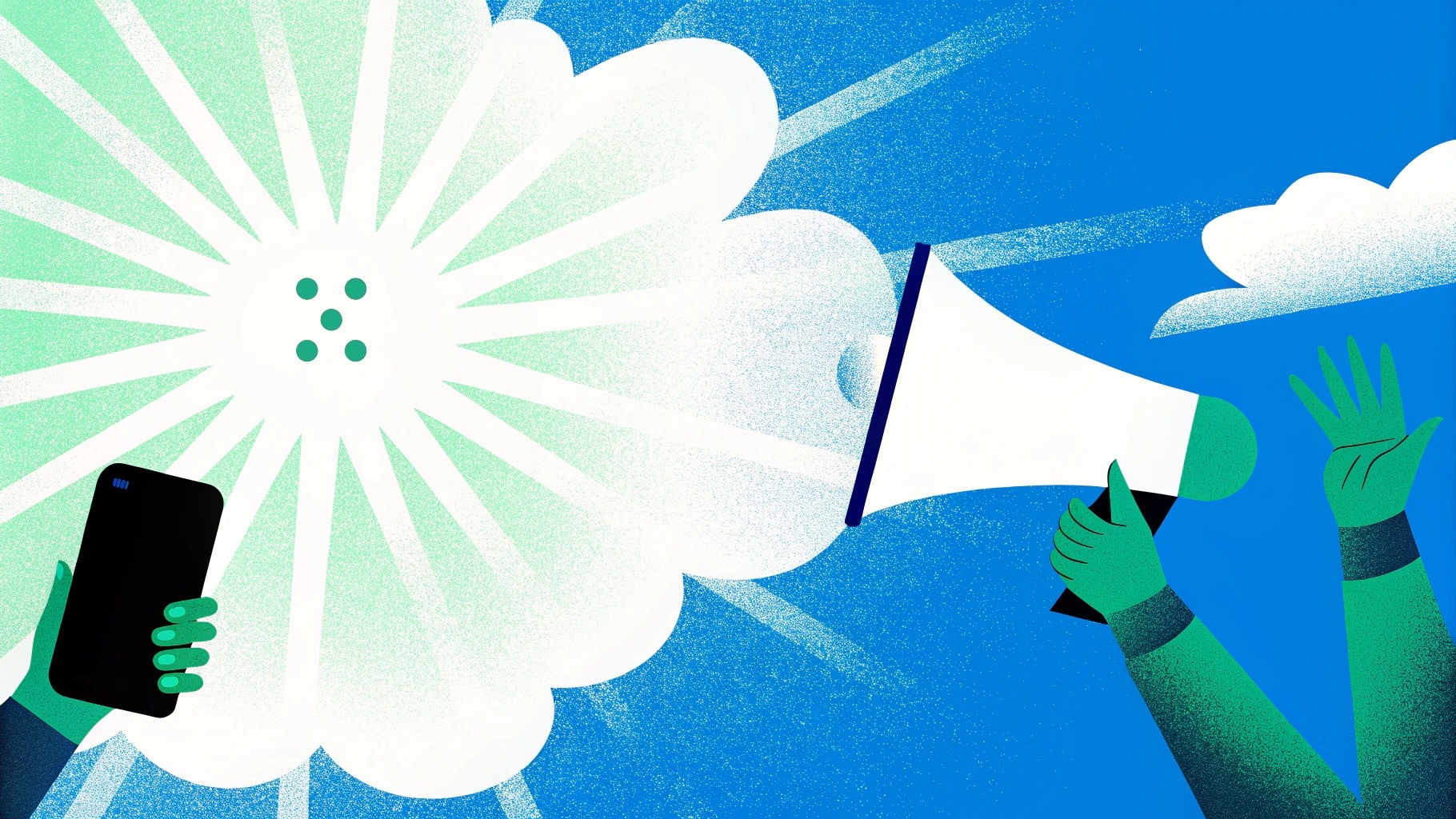When it comes to choosing the right AI platform for your marketing team in 2025, the options can feel overwhelming.
Many teams get stuck between ChatGPT Teams and Claude Team, as each promises powerful collaboration features, advanced AI capabilities, and a boost in productivity.
I’ve tested and compared these two platforms myself to see how they stack up when it comes to campaign planning, content creation, audience research, and day-to-day marketing workflows.
And while they share some similarities, they differ significantly in how they handle collaboration, scalability, and customization - the three factors that can make or break your team’s success.
That’s why I introduced a third option for all teams that will find that neither ChatGPT Teams nor Claude Teams get the job done for them - Team-GPT.
So, in this article, I’ll break down Team-GPT vs. ChatGPT Teams vs. Claude Team for marketing, covering their:
- Features.
- Pricing.
- Real-world use cases and reviews.
By the end, you’ll have a clear idea of which platform is best suited to your team’s needs, organizational structure, and goals.
Let’s begin!
TL;DR
- Team-GPT is the best choice for marketing teams that need structured collaboration, brand consistency, and model flexibility, with built-in features like prompt libraries, knowledge hubs, and usage analytics.
- ChatGPT Teams works well as a plug-and-play AI solution for teams that want easy access to OpenAI’s models, enterprise-grade security, and simple integrations.
- Claude Team shines for strategy-heavy work with its massive context windows, deep reasoning, and natural writing style, but it’s less tailored for day-to-day marketing execution.
Team-GPT vs. ChatGPT Teams vs. Claude Team - Features
When it comes to marketing, the real difference between Team-GPT, ChatGPT Teams, and Claude Team comes down to their features.
Each platform offers AI-powered collaboration, but how those features are designed - and how well they fit into a marketing workflow - varies a lot:
- Team-GPT focuses on structured teamwork, with tools for shared prompt libraries, co-editing, and organized workspaces that keep campaigns aligned.
- ChatGPT Teams is more general-purpose, offering flexible collaboration for a wide range of tasks but with fewer marketing-specific controls.
- Claude Team, on the other hand, leans into long-form content creation and deep reasoning, making it strong for strategy-heavy projects but less tailored for daily execution.
In this section, I’ll compare the standout features of each platform, so you can see which one best supports campaign planning, content production, and cross-team collaboration.
Team-GPT features
Team-GPT is an AI collaboration platform designed specifically for teams that want more structure and control than standard chat-based tools can offer.
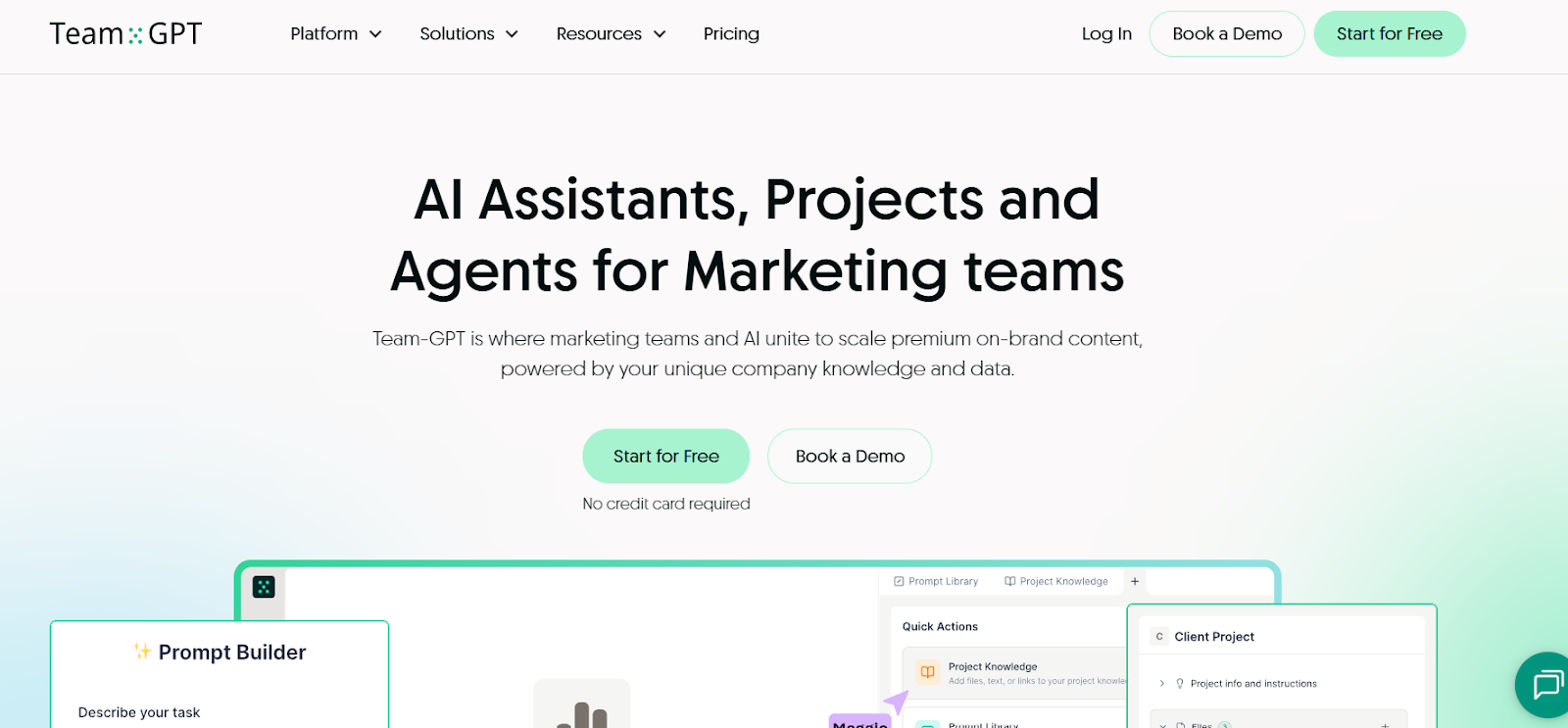
Instead of scattered prompts and siloed workflows, it brings everything into one organized space, complete with shared folders, prompt libraries, co-editing, and real-time collaboration.
For marketing teams, this means less time juggling tools and more time executing campaigns with consistency and speed.
Here are some of Team-GPT’s standout features:
Feature #1: Model-agnostic and highly customizable
One of the biggest advantages of Team-GPT is that it’s completely AI-model agnostic.
Instead of locking your team into a single provider, it gives you the freedom to switch between different models in the same chat - and even connect your own LLM.
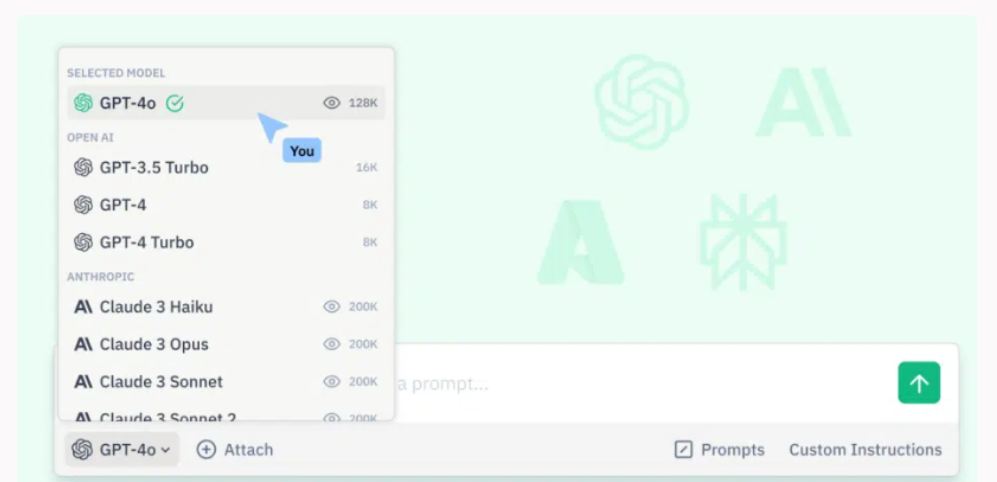
This flexibility makes it easier to match the right AI model to the right task, while keeping your whole team aligned in one platform.
Here’s how that works in practice:
- Let each team member use their preferred model: Not everyone works the same way. Team-GPT makes it possible for team members to use the AI they’re most comfortable with while still contributing to the same project.
- Seamless custom model integration: You’re not limited to pre-set models. Team-GPT lets you connect your own custom LLMs on the Enterprise plan, so your AI perfectly matches your company’s needs, workflows, and compliance standards.
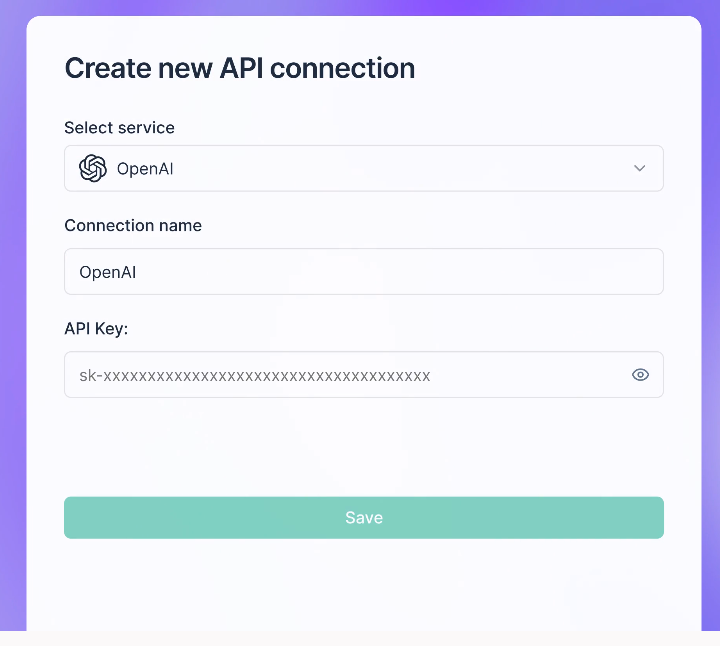
- Multitask on the same screen: Stay productive without tab overload. Split your screen to access the prompt builder, project knowledge, or start a new chat while keeping your current work visible.
- Create AI assistants for your team: Build custom assistants trained on your company knowledge, products, and services. These assistants can help with campaign planning, content creation, or customer research, with every piece of content they generate sounding consistent and on-brand.
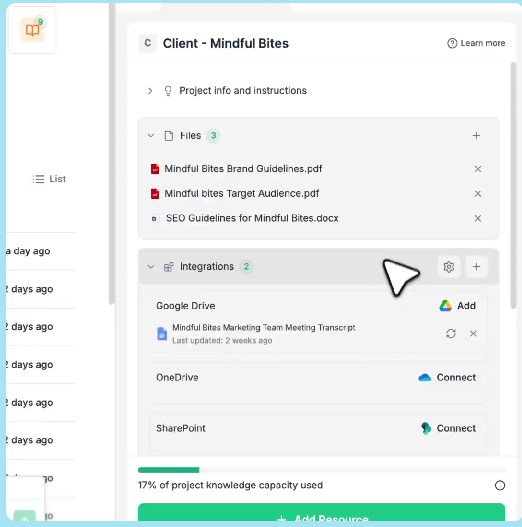
Feature #2: All-in-one AI workspace for marketers
Marketing teams don’t just need AI - they need AI that works seamlessly across every part of their workflow.
That’s where Team-GPT’s dedicated marketing toolkit comes in.
From content creation to visuals, research, and campaign execution, it brings everything into one place so your team can move faster without juggling multiple tools.
Here’s what makes it stand out:
- AI-native document editor: Write campaign briefs, strategies, and marketing docs with a collaborative editor powered by AI that understands your brand and audience. Generate first drafts instantly, then refine with interactive editing tools, such as rewrite, shorten, expand, paraphrase, or translate any paragraph with a single prompt.
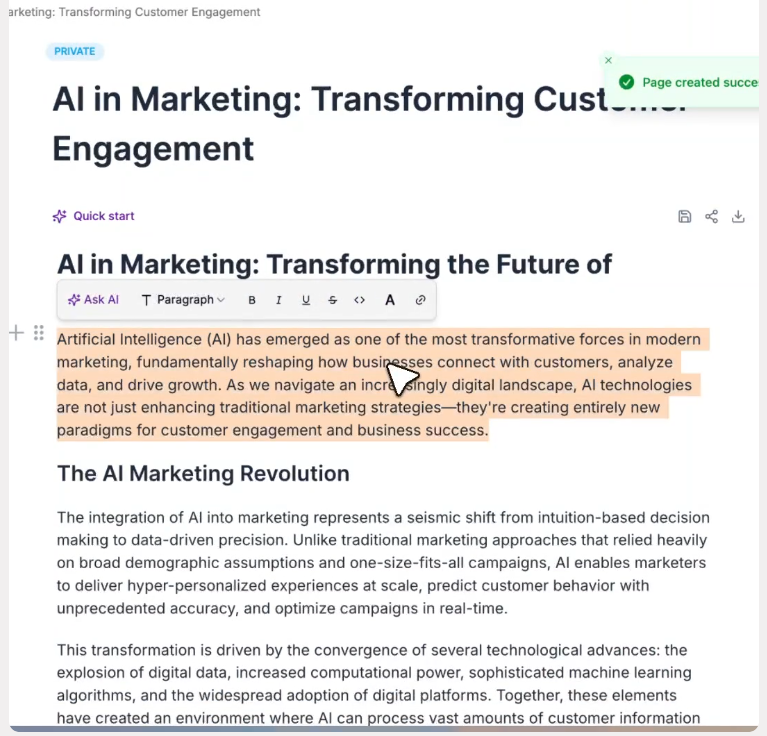
- Rich formatting built-in: Just like a traditional doc editor, you can structure content with headings, bullet points, numbered lists, and styled text, so marketing materials are polished and presentation-ready from the start.
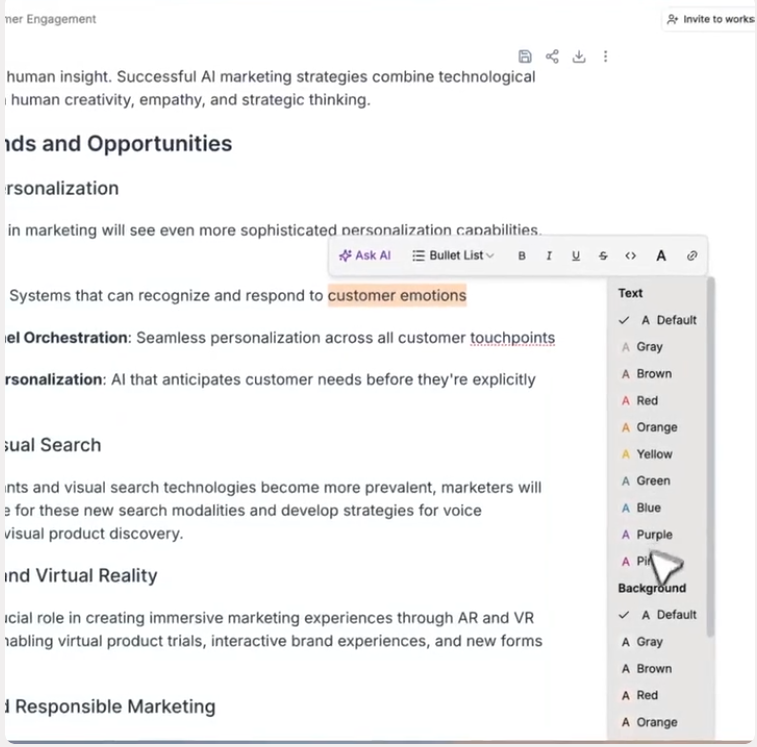
- On-demand marketing visuals: Generate professional graphics, social posts, and campaign visuals inside Team-GPT, with no external design tools or advanced skills required.
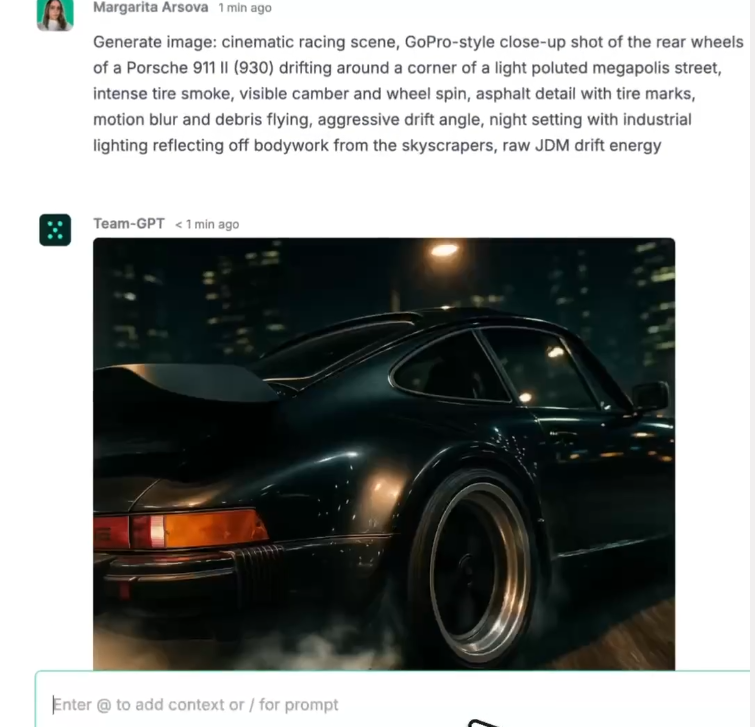
- Connected marketing stack: Sync content directly from Google Drive, Notion, SharePoint, and more to eliminate silos and streamline workflows.
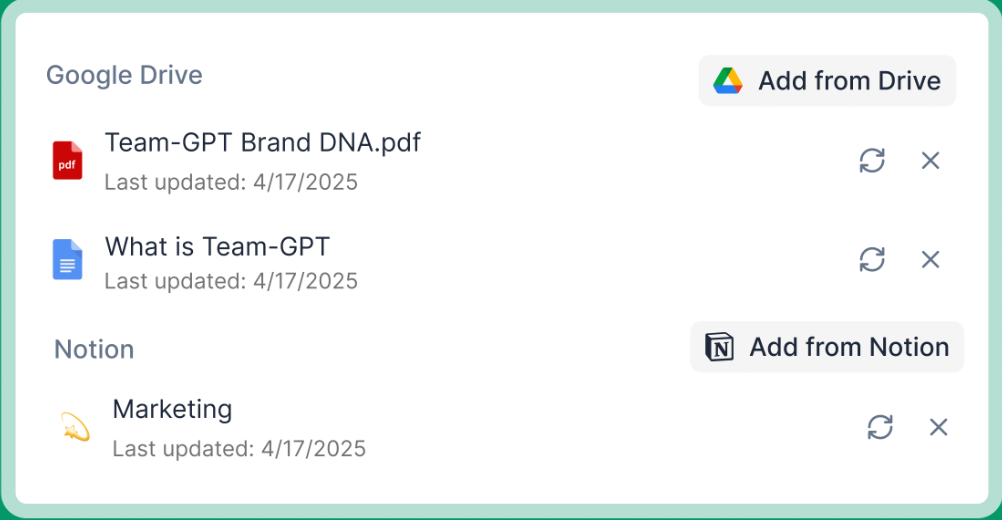
- Real-time research: Run detailed web searches without leaving Team-GPT and let the AI do the heavy lifting. Perfect for researching blog topics, validating ideas, or running quick competitor checks.
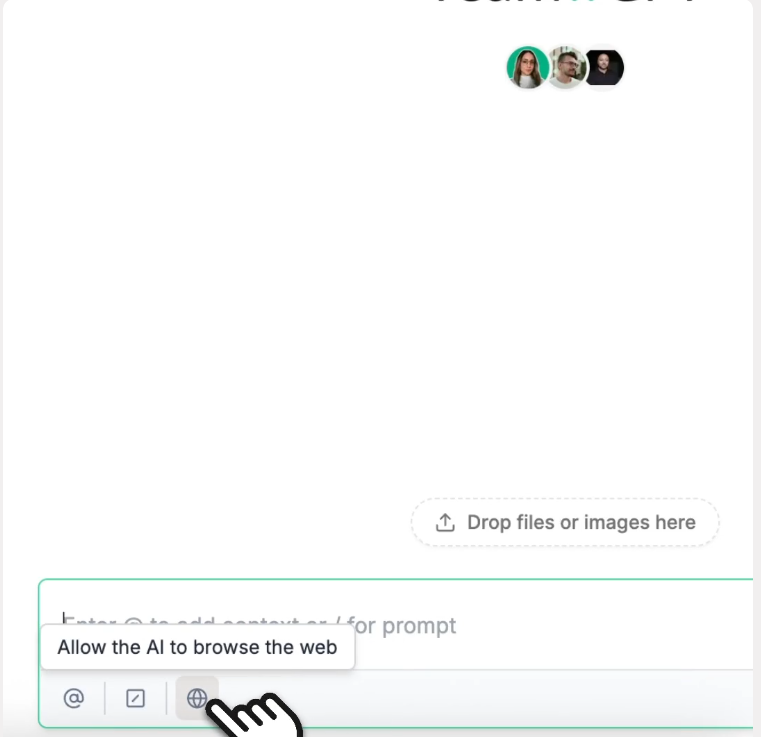
- Document & image analysis: Upload text or visuals and let AI generate insights, summaries, and enhancements, turning raw assets into actionable materials.
- Access to Playbooks: Use pre-built, step-by-step processes for common marketing tasks to speed up content production and campaign execution.
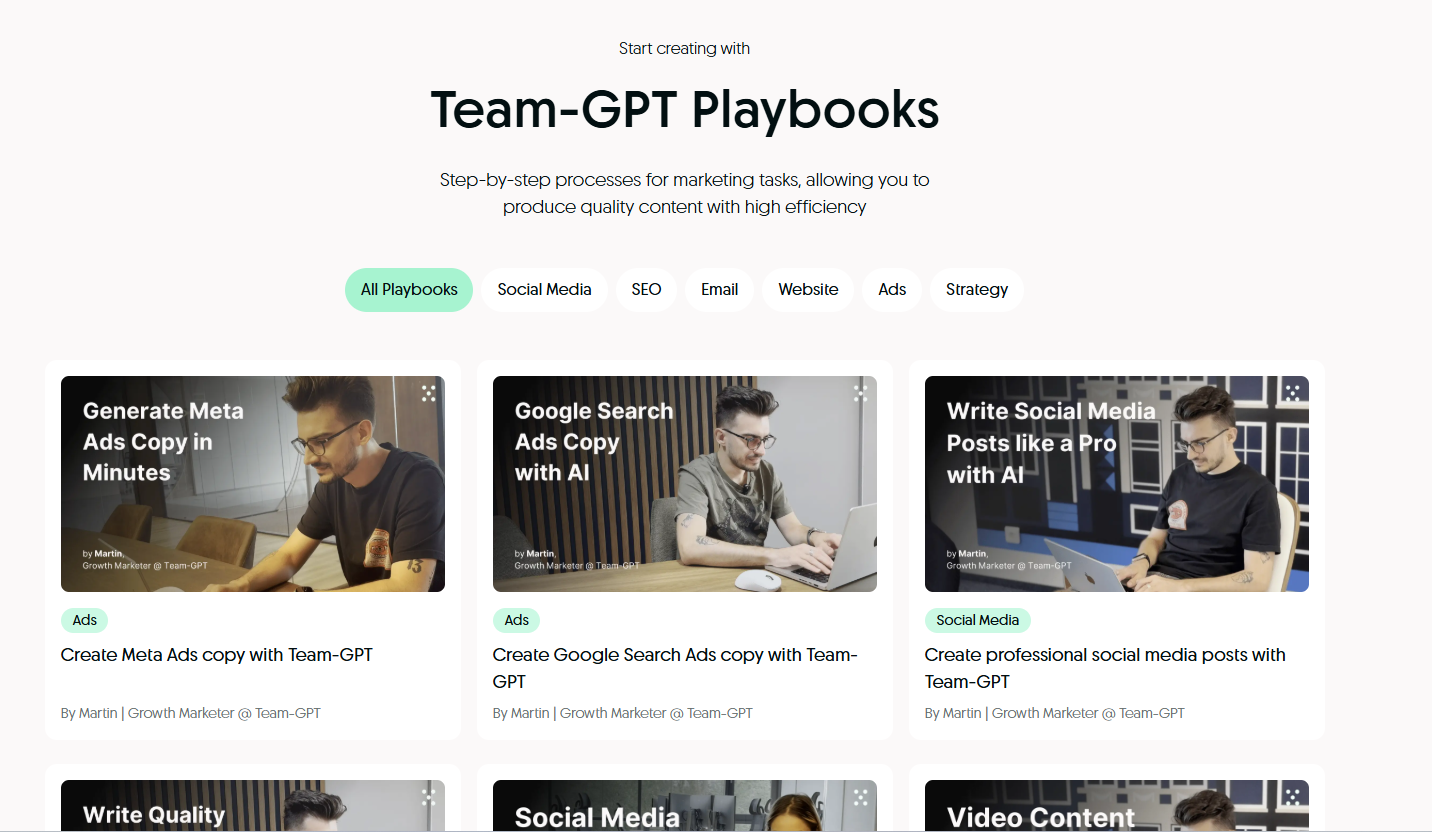
Feature #3: Smarter prompt building inside Team-GPT
One of the most powerful ways Team-GPT supports marketing teams is through its built-in Prompt Builder and custom prompt libraries.
This means that instead of having to come up with new prompts every single time or search through scattered docs, your team can create, organize, and reuse prompts tailored to specific use cases all in one place.
As a result, this ensures consistency, saves time, and makes onboarding new members effortless.
Here are some of the things you can do:
- Build perfect marketing prompts: Simply describe your use case in 1-2 sentences and get ready-to-use prompts instantly. No need for advanced “prompt engineering” skills, as Team-GPT does the heavy lifting.
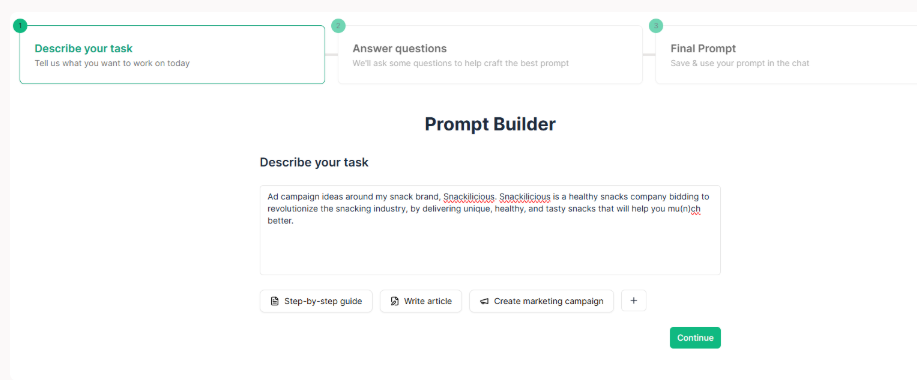
- Reusable instructions: Set up reusable prompts for tone, structure, disclaimers, or product details that AI will follow automatically. Apply them across projects so you don’t waste time rewriting the same instructions.
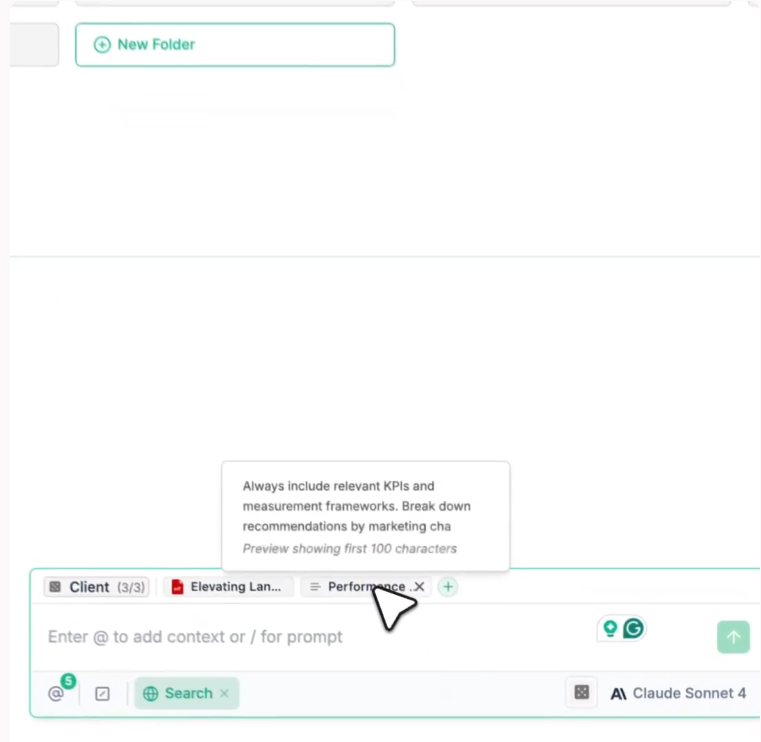
- Prompt library: Create and save prompts for any marketing task, such as email drafts, ad copy, product descriptions, and campaign strategies, and share them with your team. With a shared library, everyone stays aligned and no one has to start from scratch.
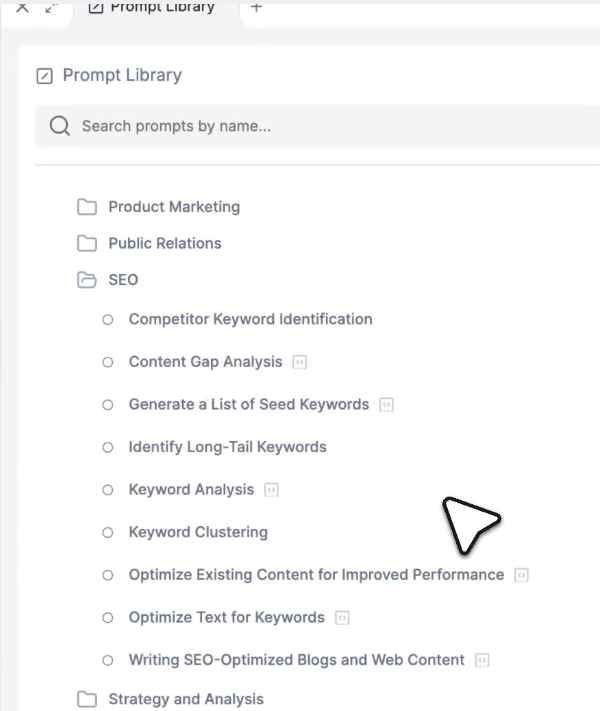
- Organized & searchable: Tag and group prompts by department, campaign, or objective so team members can easily find the right ones when they need them.
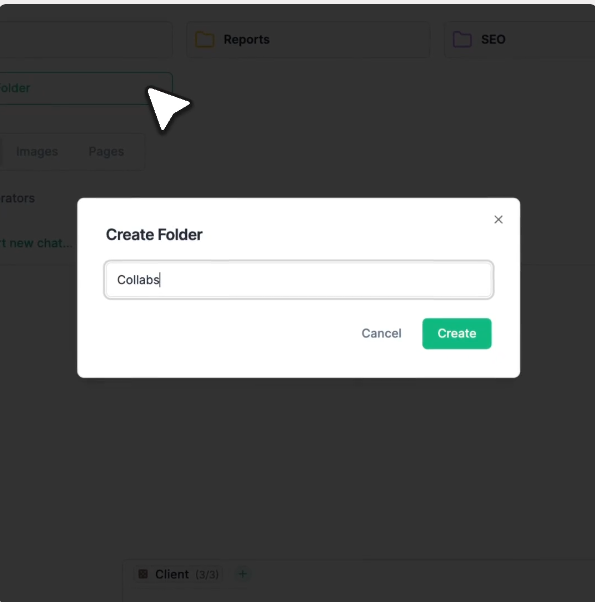
Feature #4: Centralized brand knowledge hub
Consistency is everything in marketing, and Team-GPT makes it simple by giving your team a central place to store, organize, and reuse brand knowledge.
Instead of digging through folders or old messages, you can upload assets, set instructions, and make them instantly available to the AI, so every output stays on-brand and ready to use.
Here’s how it works:
- Keep all your marketing assets in one place: Upload brand guidelines, campaign briefs, customer personas, competitor research, and more. The AI uses this context automatically to generate content that matches your voice and strategy.
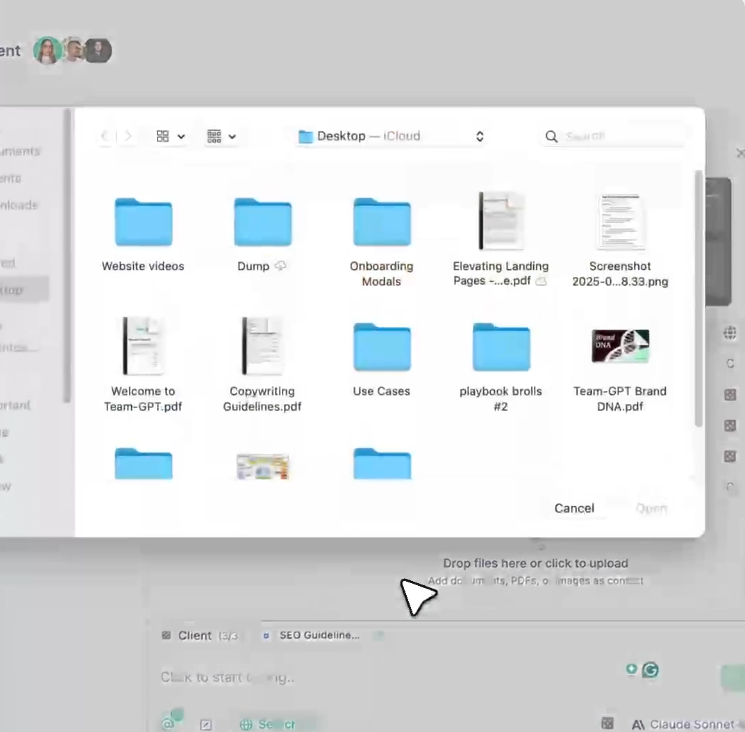
- Build once, reuse everywhere: Save time by making your most important assets, like product details, disclaimers, or tone guidelines, instantly reusable across all projects and chats.
- Stay organized with a shared knowledge base: Store voice docs, strategy slides, and research PDFs in project-specific hubs. This keeps everything structured and accessible, especially for agencies managing multiple brands.
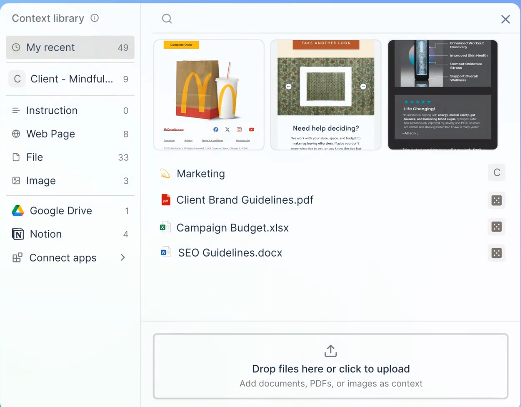
- Instant access with “@ mentions”: Pull any document, image, or asset into a chat by simply typing “@”. No searching, no switching tabs, as your team’s knowledge is always one click away.
Feature #5: Track team performance with usage analytics
AI adoption only works if your team actually uses the tools, and Team-GPT makes it easy to keep track.
With built-in usage analytics and adoption reports, you get a clear picture of how your workspace is performing, who’s using AI effectively, and where support is needed.
Here’s what you can see with Team-GPT’s detailed Adoption Reports that are structured as simple, visual dashboards:
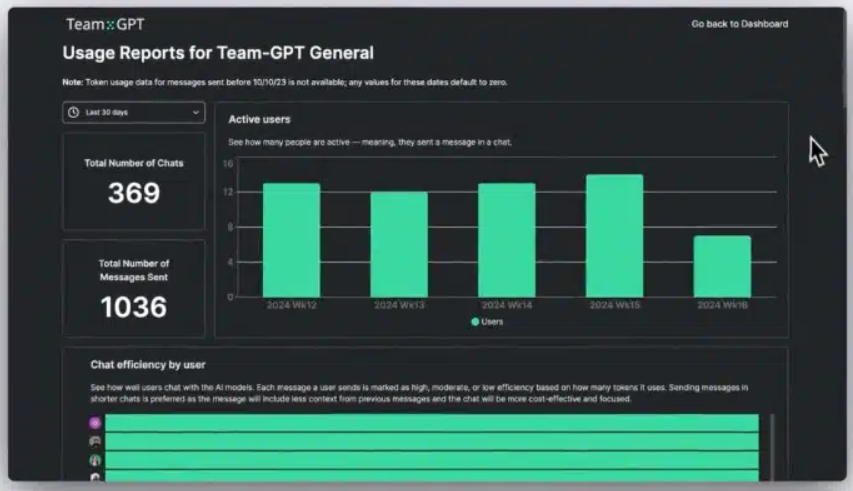
- Monthly active users: See how many unique team members are actively using Team-GPT each month and monitor long-term adoption trends.
- User breakdown by segment: Get a snapshot of your team across four usage levels (Power Users, Regular Users, Beginners, Inactive Users).
- 30-day usage trends: Explore granular activity patterns with insights into active users, adoption rate, power user count, total chats, and message distribution.
- Shared project breakdown: Compare activity across projects and see which teams are collaborating effectively and which ones may need extra support.
- User activity details: Drill down into individual engagement with data on chats created, total messages, pages created, and current usage segment.
Check out this quick guide on how to interpret and use Team-GPT’s Adoption Reports to their full potential:
Team-GPT is the right choice if:
- You want an AI platform that’s built for teams, not individuals, with shared workspaces, prompt libraries, and knowledge hubs to keep everyone aligned.
- You're looking to maintain brand consistency and you need AI assistants trained to follow your tone, guidelines, and messaging every single time.
- You’re working across multi-channel campaigns or multiple brands, and need an organized system to centralize briefs, assets, and strategies.
- You value flexibility in choosing AI models, whether switching between providers for different tasks or integrating custom LLMs for enterprise-grade needs.
- You care about measuring adoption and ROI, with usage analytics that show who’s using AI, how often, and where to provide support.
Team-GPT may not be the best fit if:
- You’re mainly an individual user who just needs quick chats or one-off content without team-wide structure.
- You’re looking for a minimal, plug-and-play AI chat tool instead of a scalable workspace with deep customization.
ChatGPT Teams features
ChatGPT Teams is OpenAI’s self-serve plan tailored for fast-moving companies that want to bring AI into their workflows without getting bogged down in complex setup.
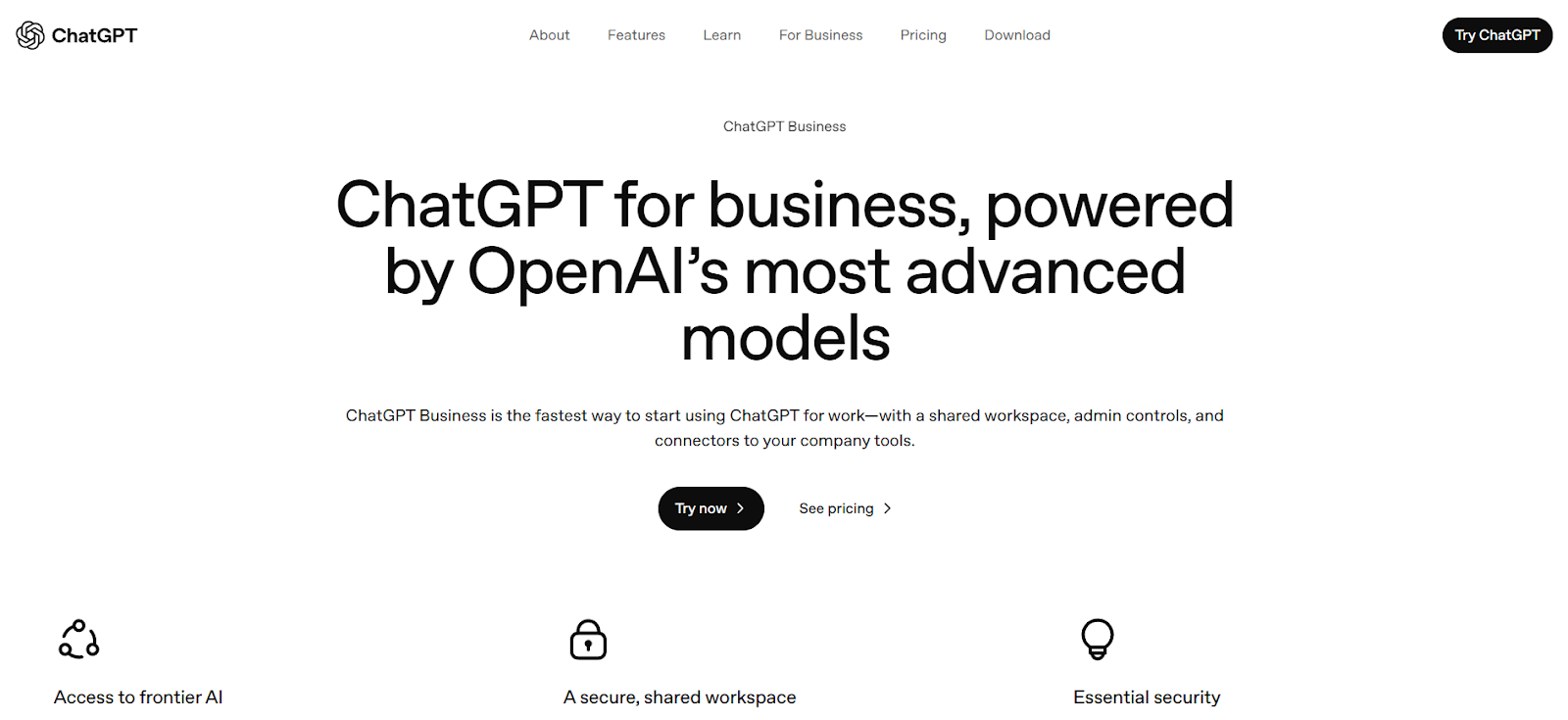
On this plan, teams get a shared workspace, admin controls, unified billing, and generous access to advanced models such as GPT-5.
Moreover, it lets you connect ChatGPT to your internal tools (via connectors), collaborate on GPTs, run deep research, and generate visuals, all secured with features like SAML SSO and data encryption.
Below, I’ll walk through the key features of ChatGPT Teams from a marketing lens, including what works well, and where it may fall short compared to something like Team-GPT.
Note: As of the end of August this year, ChatGPT Teams has been rebranded as ChatGPT Business. Its features and pricing remain unchanged.
Feature #1: Custom GPTs for specialized workflows
With ChatGPT Teams, in addition to using ready-made specialized GPTs, you can also create and share custom GPTs trained on your own instructions, files, or style preferences.
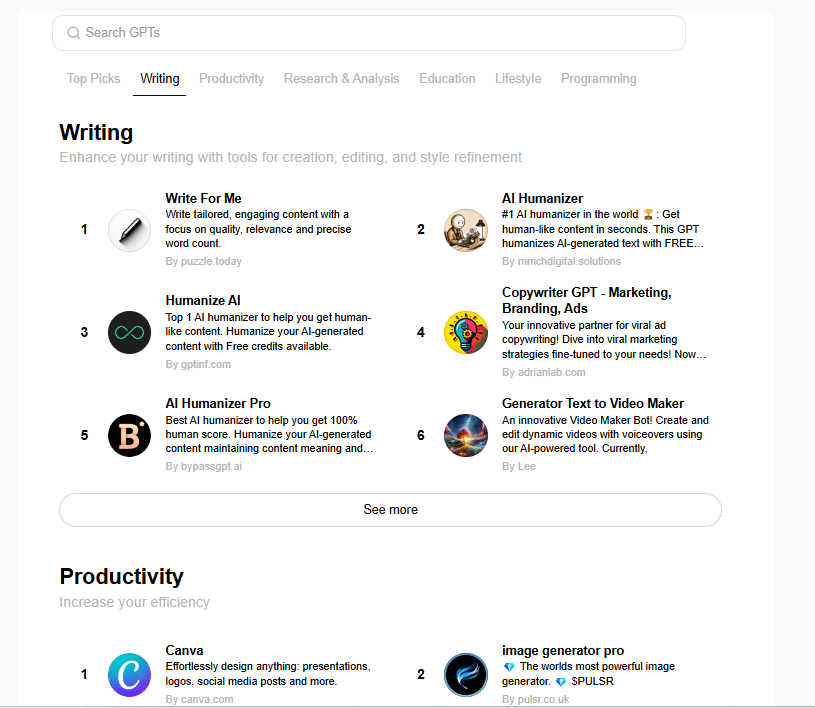
This helps teams:
- Build reusable assistants for tasks like SEO optimization, ad copy generation, or market research.
- Standardize workflows across projects by giving everyone access to the same custom GPTs.
- Reduce repetitive work by automating specialized marketing tasks.
Feature #2: Integrations with external tools
ChatGPT Teams connects directly with tools like Google Drive, Microsoft 365, and third-party apps through its integrations and API support.
This makes it easy to:
- Pull in files, data, and references directly into your workspace.
- Export campaign briefs, reports, or strategies straight into your existing stack.
- Keep your AI workflows connected instead of siloed.
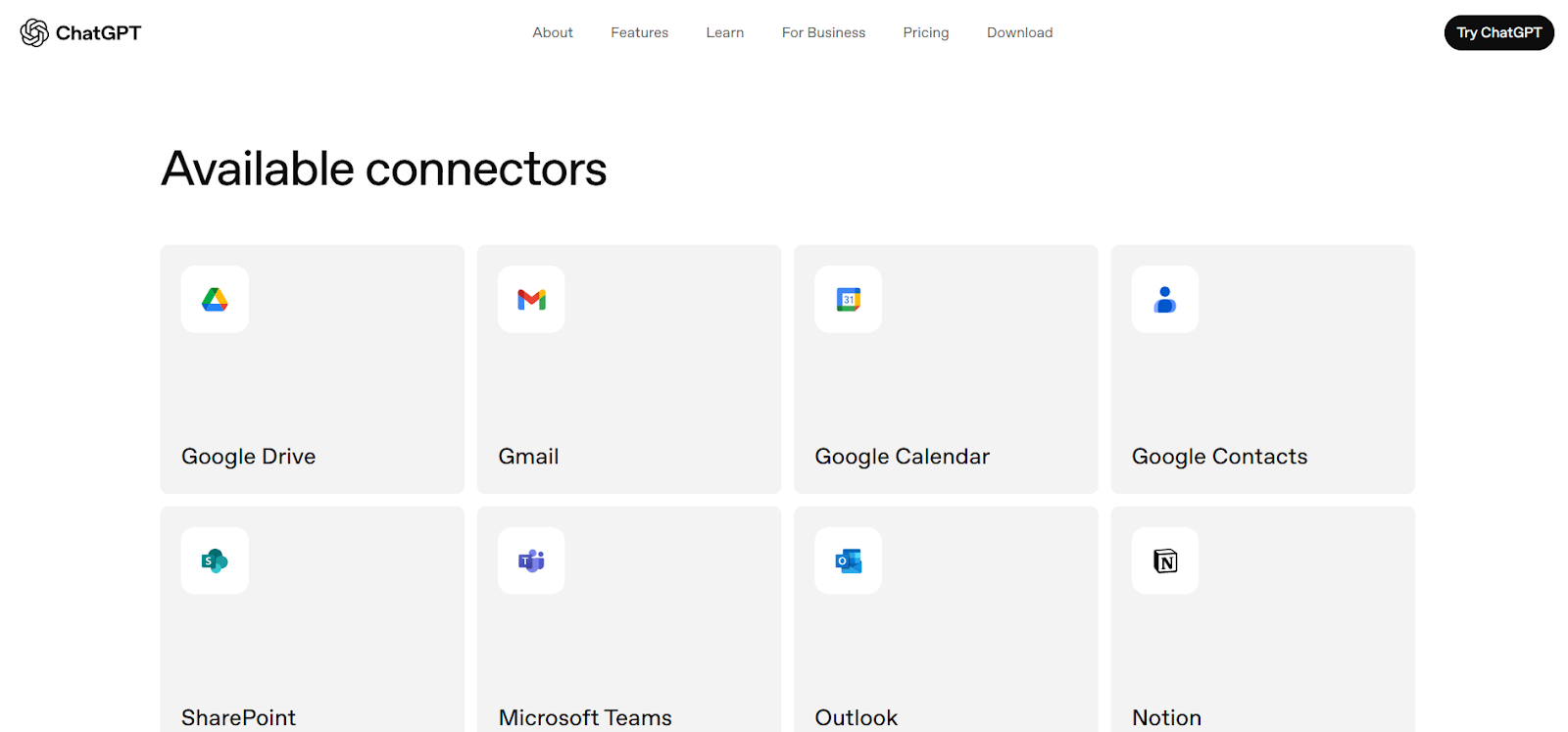
As a result, your campaign research, content drafts, and final assets can flow seamlessly into the tools your team already uses.
Feature #3: Built-in agents for deep research and automation
One of the newer additions to ChatGPT Teams is access to built-in agents like Deep Research and Codex.
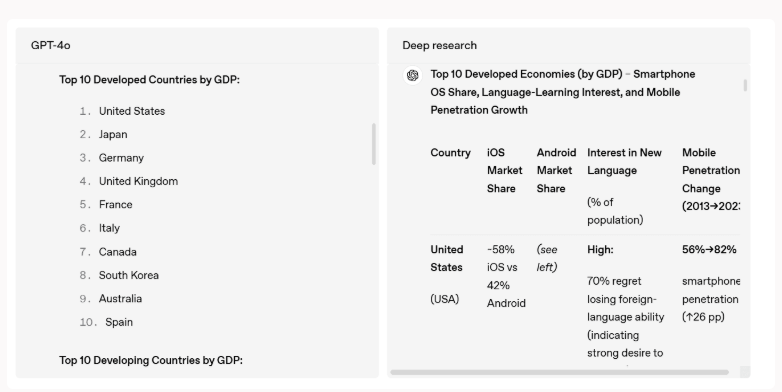
These go beyond single-prompt interactions, acting as specialized assistants for multi-step workflows.
Here’s what they bring to marketing teams:
- Deep Research Agent: Automates complex research by scanning the web and your connected files. Instead of a quick answer, it delivers structured insights and summaries, perfect for competitor benchmarking, industry trend reports, or campaign ideation.
- Codex Agent: Originally known as OpenAI’s coding model, Codex is now embedded to handle automation, scripts, and data tasks. For marketers, this could mean automating campaign reporting, cleaning up datasets, or even tackling technical SEO issues.
Together, these agents turn ChatGPT Teams into a workflow orchestrator, helping teams cut down on manual research and repetitive tasks.
Feature #4: Enhanced data security and admin controls
For marketing teams working with sensitive data (like customer insights or campaign budgets), ChatGPT Teams offers enterprise-grade security, including SAML SSO, domain verification, and data encryption.
Admins also get:
- Centralized control over user permissions.
- Activity oversight to ensure compliance.
- Unified billing for easy cost management.
ChatGPT Teams is the right choice if:
- You already use OpenAI’s models and just want to extend their use to your entire department or organization.
- You prefer a general-purpose solution that can be shaped for many use cases.
- Your team values plug-and-play AI that works out of the box for brainstorming, drafting, visuals, and quick research.
ChatGPT Teams may not be the best fit if:
- You need a platform that goes beyond general AI and is built for structured team collaboration, with shared prompt libraries, knowledge hubs, and reusable instructions.
- You care about tracking adoption and measuring ROI with detailed usage analytics to see who’s actually leveraging AI inside your team.
- Your campaigns span multiple brands or complex workflows and require customizable workspaces to keep everything organized.
Claude Team features
Claude Team is Anthropic’s team-focused plan, built on the Claude family of models.
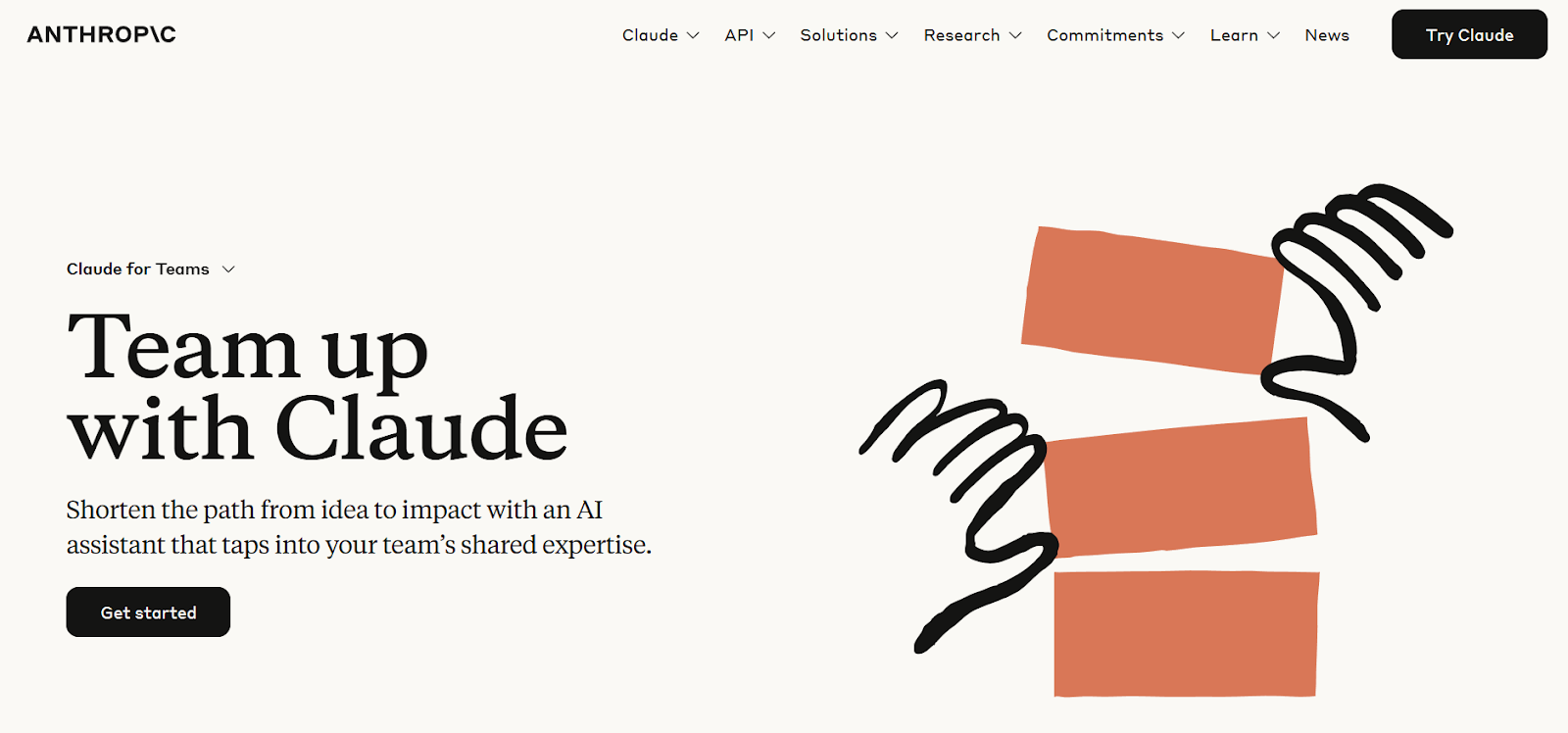
Unlike general-purpose AI tools, Claude is known for its longer memory, deep reasoning, and ability to handle massive context windows.
For marketing teams, that translates into a platform that’s particularly strong for strategy-heavy work, knowledge management, and content that requires nuance.
Here are some of the features that stand out:
Feature #1: Industry-leading context windows
With up to 200K tokens (hundreds of pages), Claude can handle more content at once than most models on the market.
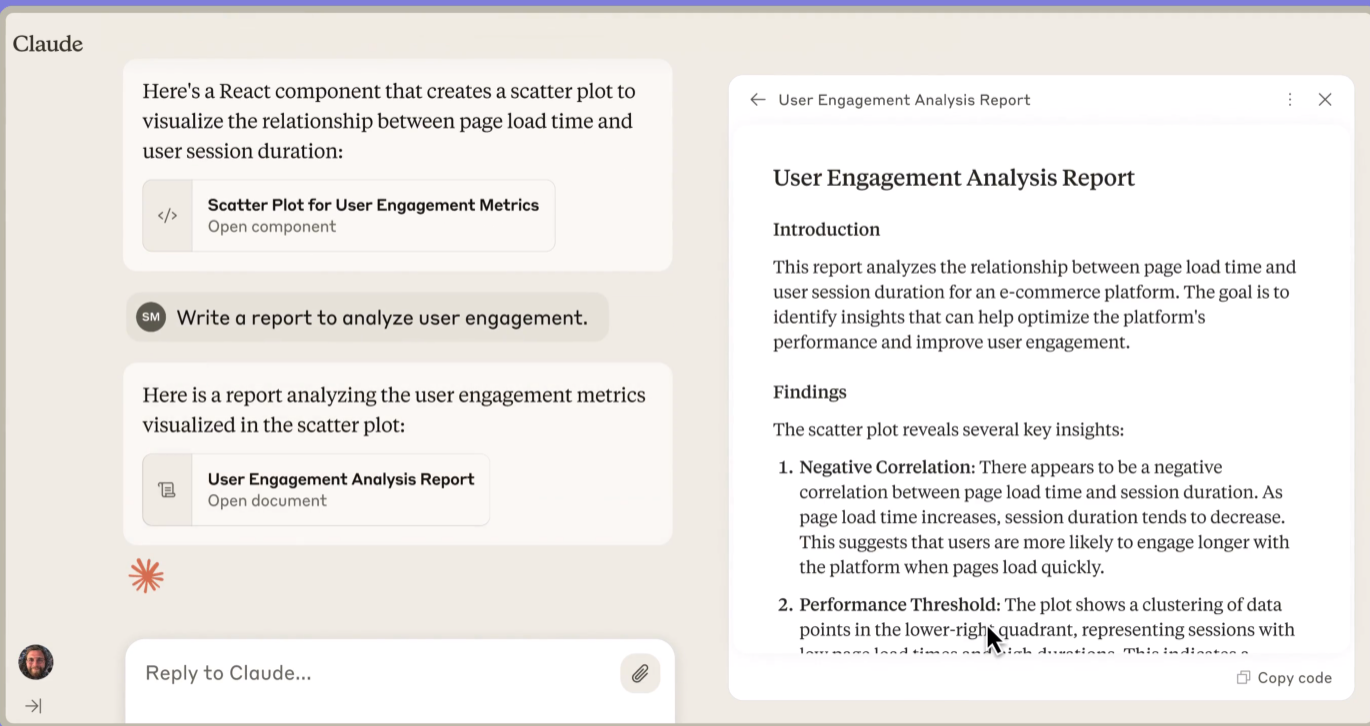
This allows marketing teams to:
- Upload research decks, customer personas, or entire campaign briefs and work with them seamlessly.
- Keep long-running strategy discussions without losing context.
- Draft or edit complex, long-form marketing content without hitting model memory limits.
Feature #2: Natural, human-like writing style
Claude is widely praised for producing writing that feels clear, empathetic, and human-like, making it a favorite for:
- Drafting long-form blog posts, guides, or reports.
- Customer-facing content where tone and readability are critical.
- Internal docs and communications that need to be professional yet accessible.
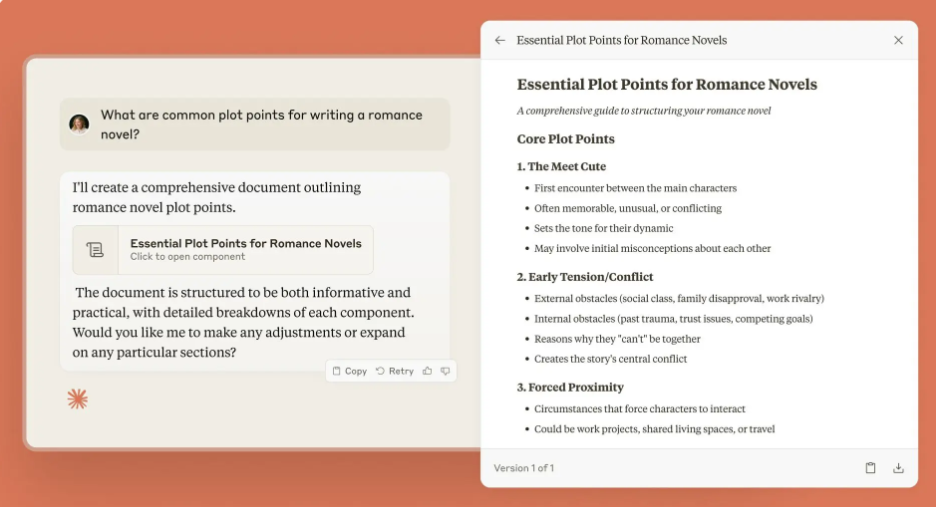
This makes Claude perfect for things like thought leadership content and materials where tone carries as much weight as the information itself.
Feature #3: Artifacts for interactive creation
Claude Team’s Artifacts feature lets you create and refine live documents, code, and visuals directly alongside your chat.
Instead of copying outputs into another tool, you can draft, edit, and iterate in real time inside Claude’s workspace.
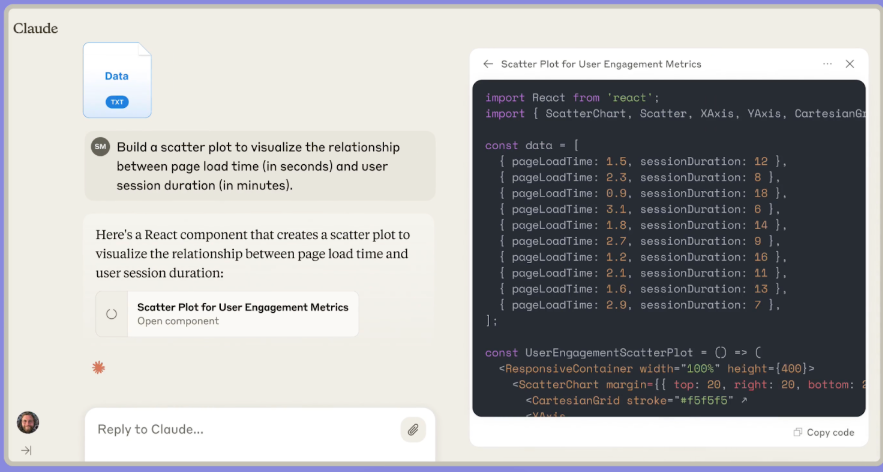
Here’s what you can do with Artifacts:
- Draft campaign assets: Write and refine landing pages, marketing emails, or campaign briefs with live editing.
- Build interactive visuals: Generate flowcharts, diagrams, or even basic dashboards to map out customer journeys or campaign timelines.
- Prototype websites and code: Quickly create microsite mockups or HTML/CSS snippets for campaigns and tweak them with AI guidance.
- Iterate without losing track: Keep multiple artifacts in one project, review versions, and refine them in context.
Feature #4: Flexible access to Claude’s models
With Claude Team, you don’t just get one model - you can switch between all three Anthropic AI models, each built for different use cases:
- Opus excels at deep reasoning and long-form content, making it a strong fit for strategy documents, research, or detailed campaign reports.
- Sonnet balances speed and accuracy, ideal for day-to-day tasks like drafting marketing copy, outlining projects, or team planning.
- Haiku is the fastest option, designed for quick outputs such as ad variations, email subject lines, or brainstorming sessions.
This means your team can always choose the right tool for the job instead of forcing one model to handle every task.
Claude Team is the right choice if:
- You need an AI that can process huge amounts of information at once.
- Your marketing relies on long-form, thoughtful content like whitepapers, in-depth reports, or detailed competitor analysis.
- You want AI that produces empathetic, human-like writing suitable for customer-facing content where tone and nuance are critical.
- You see potential in Artifacts for prototyping landing pages, campaign emails, diagrams, and microsites directly inside your workspace without switching tools.
Claude Team may not be the best fit if:
- You want to integrate custom LLMs or use AI models beyond Anthropic’s models.
- Your top priority is marketing-focused content creation. While Claude handles long-form writing well, it lacks dedicated marketing features like Pages, visual generation, and rich formatting tools that platforms such as Team-GPT provide.
- You’re looking for robust analytics and adoption reporting to track usage and ROI across your team.
- Visual creation is a key part of your workflow. Claude’s Artifacts are powerful for text, code, and diagrams, but it’s not a replacement for a dedicated design or creative AI tool.
Winner: Team-GPT takes the win with its model-agnostic flexibility, built-in prompt libraries, centralized brand knowledge hub, and AI assistants trained on your guidelines that give marketers exactly what they need to scale campaigns without sacrificing consistency.
Team-GPT vs. ChatGPT Teams vs. Claude Team - Team collaboration capabilities
AI is powerful on its own, but for marketing teams, collaboration is where the real impact happens.
The way each platform handles shared workspaces, project organization, and knowledge management can make or break productivity.
While all three offer ways to work together, they approach collaboration very differently.
In this section, I’ll break down how each platform supports teamwork, and which one gives marketers the best balance of structure, flexibility, and control.
Team-GPT’s collaboration capabilities
Collaboration is where Team-GPT really sets itself apart.
Instead of scattered chats and disconnected assets, it gives marketing teams structured spaces to work together, organize knowledge, and keep every campaign aligned.
Here’s how Team-GPT makes collaboration seamless:
- Dedicated Projects: Group related work into Projects, ensuring that the AI will always have the right context. Organize by client, campaign, or task so your team works smarter in focused spaces.
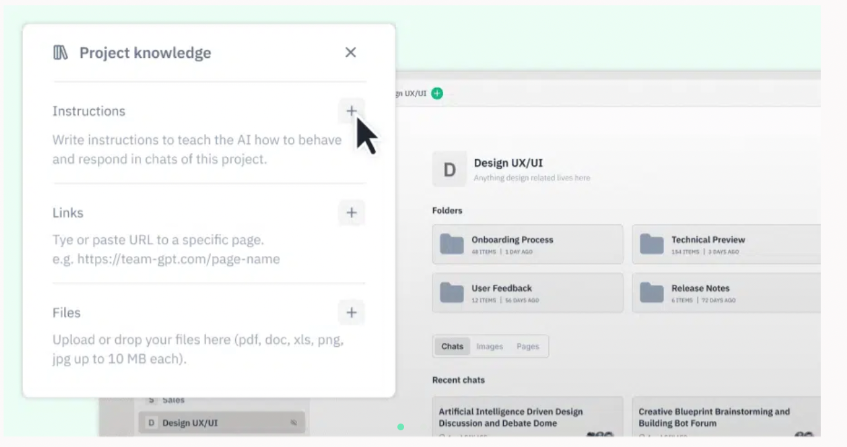
- Project knowledge bases: Upload brand guidelines, briefs, research, and assets once, and Team-GPT will automatically apply them across every chat and page in that project.
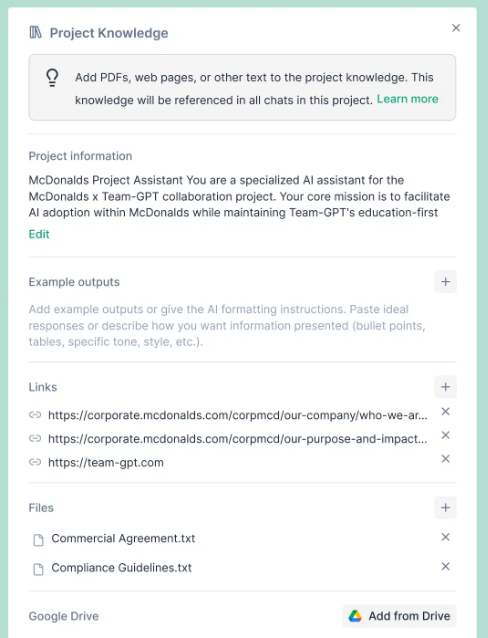
- Real-time collaboration: Brainstorm, co-write, and edit prompts or pages together, just like working in a shared Google Doc, but AI-powered.
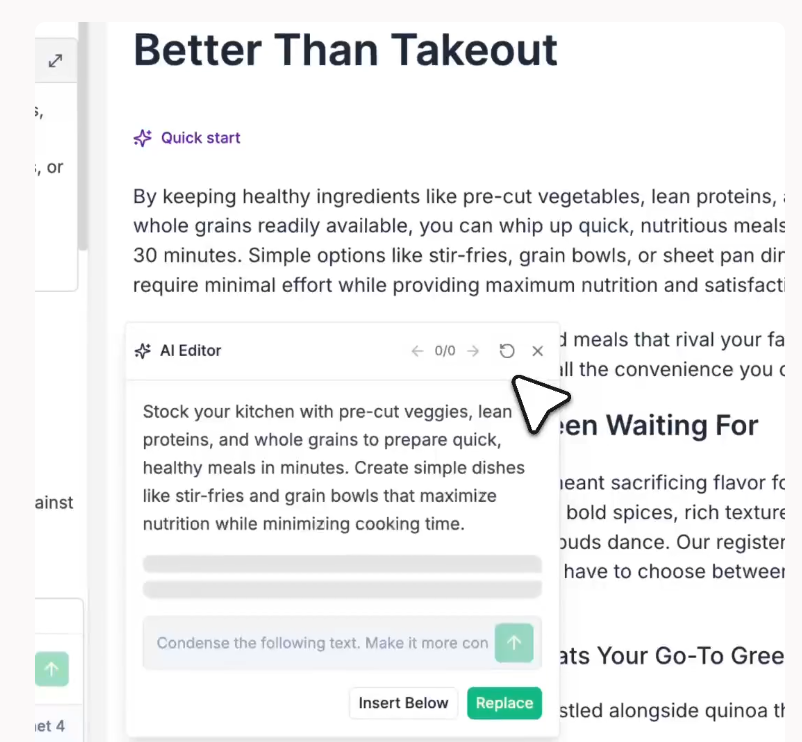
- Cross-model flexibility: Use multiple AI models (OpenAI’s GPT-4/5, Claude, Gemini, Mistral, or custom LLMs) within the same workspace and even compare outputs side by side.
- Fork conversations: Branch off from existing chats to explore new directions while keeping the original context intact. Perfect for testing different campaign angles or message variations.
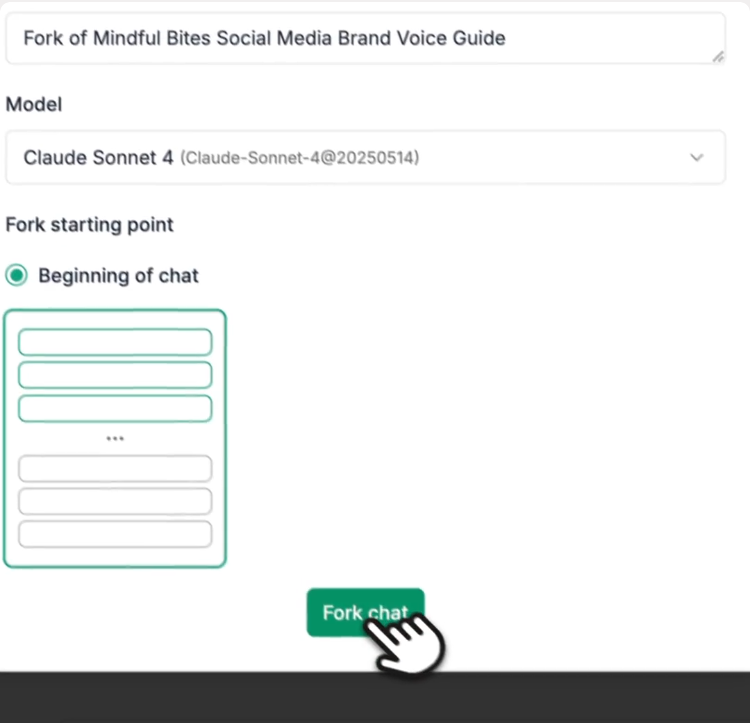
- Access controls: Keep sensitive work private or grant access to the right teammates. Manage collaboration securely while still enabling contribution from across the team.
ChatGPT Teams’ collaboration features
ChatGPT Teams offers straightforward collaboration features that make it easy for teams to work together inside a shared AI workspace.
It’s designed to be plug-and-play, giving teams access to advanced models with minimal setup, while still providing the admin controls companies expect.
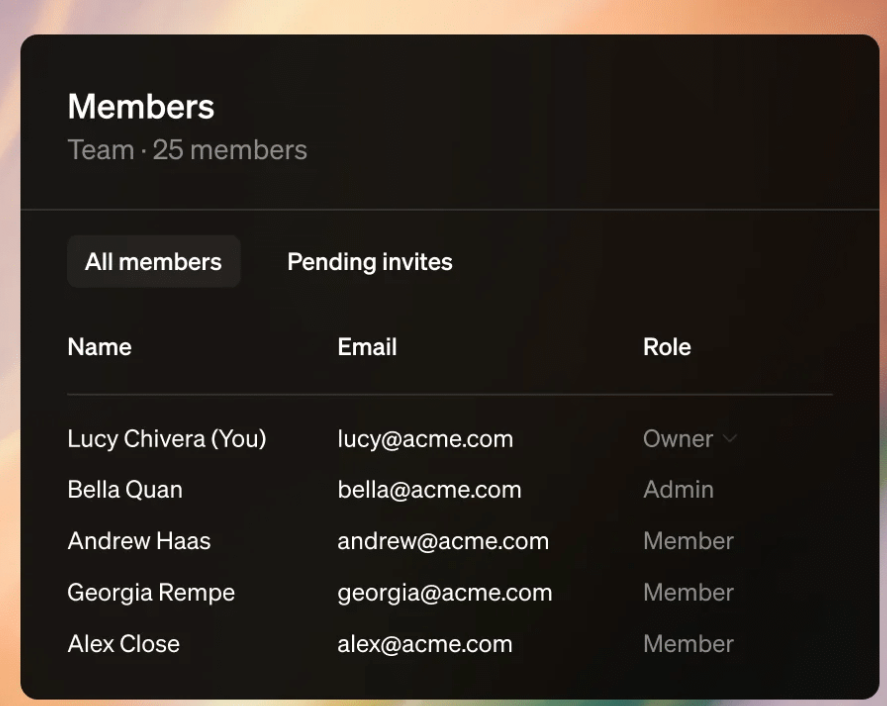
Here’s how collaboration works in ChatGPT Teams:
- Shared workspace: All team members work within the same environment, with unified billing and centralized access to projects and conversations.
- Basic access controls: Admins can manage user permissions, monitor workspace activity, and ensure security with features like domain verification and SAML SSO.
- Simple sharing: Team members can share GPTs, chats, and outputs with each other for reuse or further editing, but collaboration feels more “hand-off” than real-time co-editing.
Claude Team’s collaboration capabilities
Claude Team is designed with collaboration in mind, but its approach is more about shared knowledge and long-context discussions than structured workspace features.
It’s strongest when teams need to collectively analyze complex documents or build long-form strategies together.
Here’s how Claude supports collaboration:
- Projects for shared context: Organize chats, documents, and custom instructions into Projects so everyone on the team works with the same context and resources.
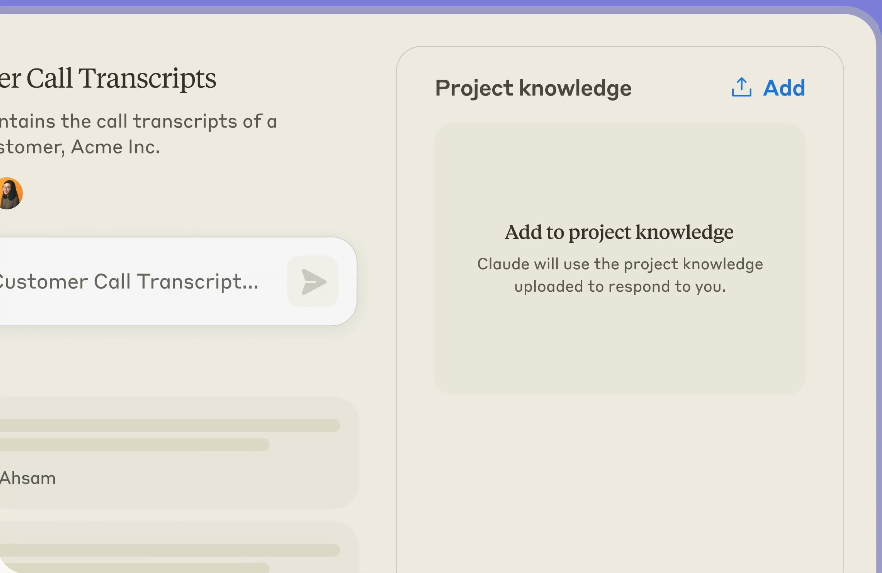
- Artifacts for collaboration: Draft documents, campaign mockups, code, and diagrams in real time. Teammates can iterate on these Artifacts within the same project, reducing tool-switching.
- Prompt & instruction sharing: Teams can store reusable prompts and set system instructions for brand tone or project objectives, keeping outputs aligned across members.
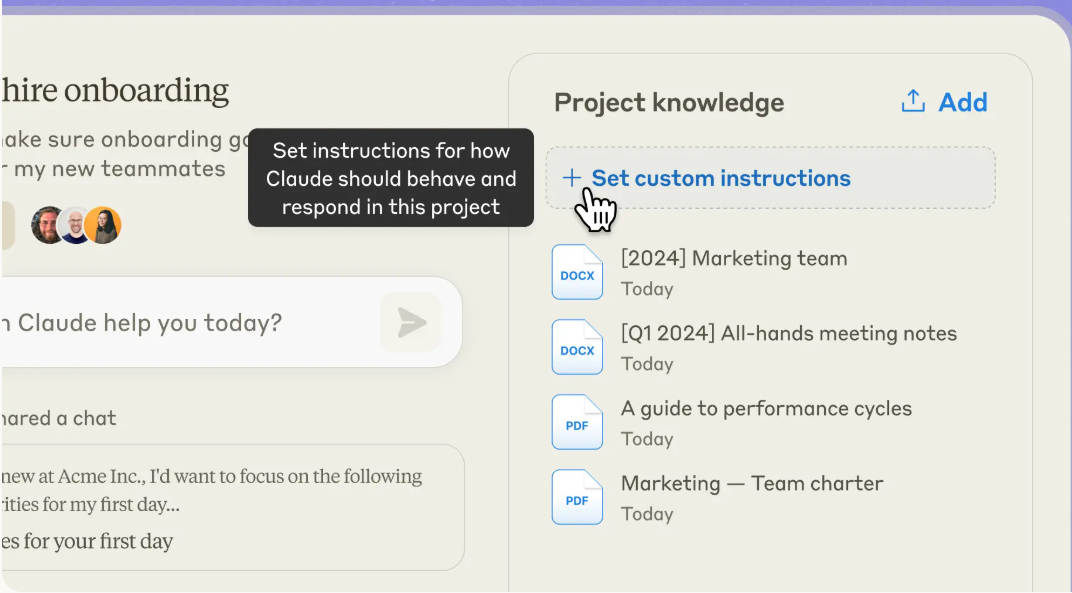
- Team visibility: Members can access shared conversations, see reasoning trails, and build on each other’s work, which is useful for strategy sessions or research-heavy campaigns.
Winner: For marketing teams, the clear winner is Team-GPT. Its dedicated Projects, persistent knowledge bases, real-time co-editing, and cross-model flexibility make it far more than a shared chat space - it’s a true collaboration hub.
On the other hand, ChatGPT Teams makes collaboration simple and accessible with shared workspaces, custom GPTs, and integrations into familiar tools, while Claude Team excels when collaboration means tackling complex, knowledge-heavy projects together, with its huge context windows, Projects, and Artifacts for drafting and iterating in real time.
Team-GPT vs. ChatGPT Teams vs. Claude Team - Pricing
The right AI platform isn’t just about features - it’s also about finding a plan that actually fits your team’s budget and scale.
Team-GPT, ChatGPT Business, and Claude Team each take a very different approach to pricing.
Some aim for flexibility with transparent, per-seat models, while others position themselves as premium solutions for larger organizations.
Let’s take a closer look at what each platform charges, what’s included, and how the value stacks up for marketing teams.
Team-GPT Pricing
Team-GPT has pricing plans built to fit teams at every stage - from small marketing groups just testing the waters with AI to large enterprises running campaigns across multiple brands.
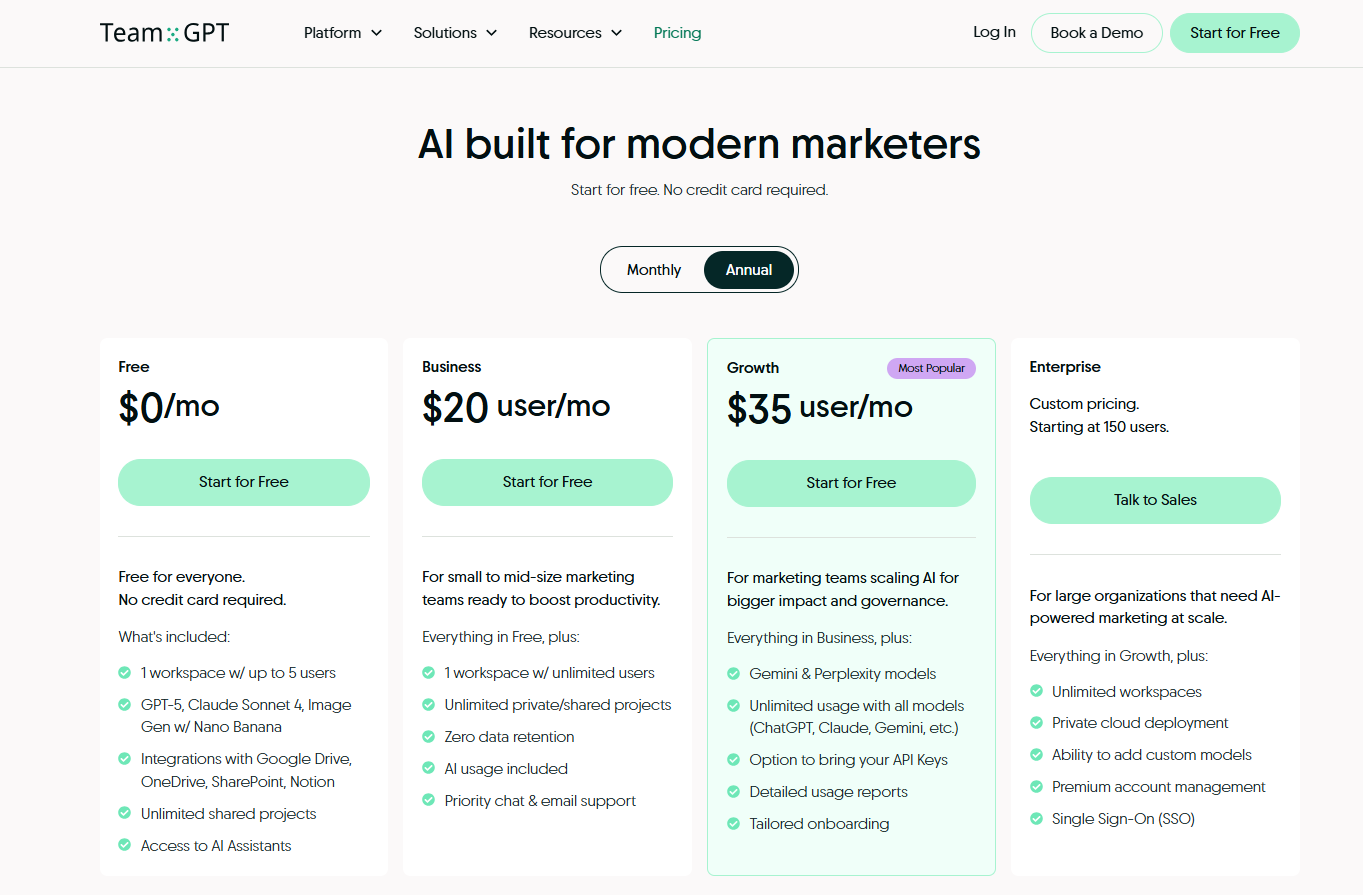
First of all, there’s a free forever plan, which is ideal for individuals or small teams getting started.
On it, you can invite up to 5 team members and get access to:
- Gemini 2.5 Pro for chatting and image generation.
- File uploads and integrations with Google Drive, OneDrive, SharePoint, Notion, and more.
- Built-in tools like Prompt Builder and Text Humanizer.
- Unlimited projects, chats, and pages for seamless collaboration.
When it comes to the paid plans, there are three to choose from:
- Business ($20/mo per user), best suited for small to mid-sized marketing teams that want to move beyond experimenting.
Includes everything in Free, plus:
- Access to the latest models from OpenAI & Anthropic.
- Usage analytics and team insights.
- Priority chat & email support.
- Growth ($35/mo per user), designed for scaling teams ready to make AI a core part of their workflows.
Includes everything in Business, plus:
- Unlimited AI messages with all models (ChatGPT, Claude, Gemini, Perplexity, and more)
- Option to bring your own API keys.
- Tailored onboarding for smoother adoption
- Enterprise (Custom pricing, starting at 150 users), built for global enterprises that need security, scale, and control.
Includes everything in Growth, plus:
- Unlimited workspaces for large or multi-brand teams.
- Private cloud deployment for enhanced security.
- Ability to add custom models.
- Premium Key Account Management.
- Enterprise-grade security measures.
- Single Sign-On (SSO).
ChatGPT Teams pricing
ChatGPT Teams is positioned as OpenAI’s secure, enterprise-ready workspace.
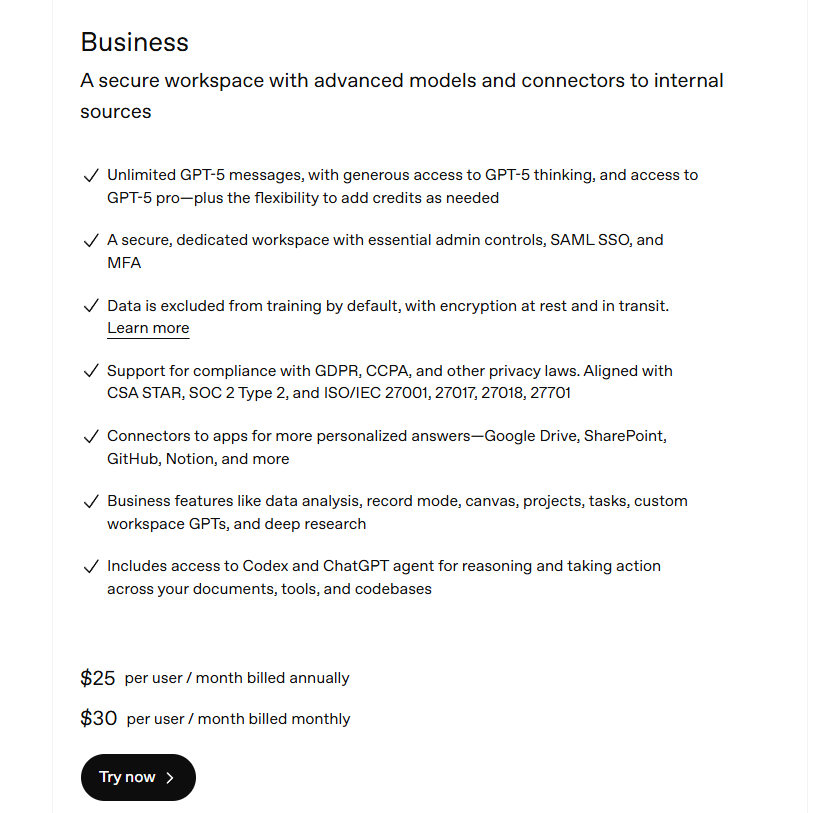
It combines access to the latest models with strong compliance and security standards, making it appealing for companies that want AI at scale without compromising on governance.
The plan will cost you $25/user/month when billed annually or $30/user/month when billed monthly, and it includes:
- Unlimited GPT-5 messages, with generous access to GPT-5 Thinking and GPT-5 Pro.
- Secure, dedicated workspace with admin controls, SAML SSO, and MFA.
- Data excluded from training by default, plus encryption at rest and in transit.
- Compliance with GDPR, CCPA, CSA STAR, SOC 2 Type 2, and ISO/IEC standards (27001, 27017, 27018, 27701).
- Connectors to Google Drive, SharePoint, GitHub, Notion, and more.
- Built-in features like data analysis, record mode, canvas, projects, tasks, custom workspace GPTs, and deep research.
- Access to Codex and ChatGPT Agents for reasoning and automating workflows across documents, tools, and codebases.
Note: There’s a 2+ users minimum.
For more details on ChatGPT pricing and value for money, take a look at our in-depth ChatGPT pricing guide.
Claude Team pricing
Claude Team is built for organizations that need more usage, admin oversight, and structured project management than the individual Pro plan allows.
Pricing is straightforward, with two types of seats available:
- Standard seat: $25/user/month (annual) or $30/user/month (monthly) with a minimum of 5 seats required. Includes:
- Everything in Claude Pro (Projects, Research, integrations with Google Workspace, and access to more Claude models).
- Higher usage allowances compared to consumer plans.
- Centralized billing and administration tools.
- Early access to collaboration features as they roll out.
- Premium seat: $150/user/month, also a minimum of 5 seats required. Includes everything in Standard, plus:
- Access to Claude Code, Anthropic’s native coding assistant for automation, debugging, and workflow support.
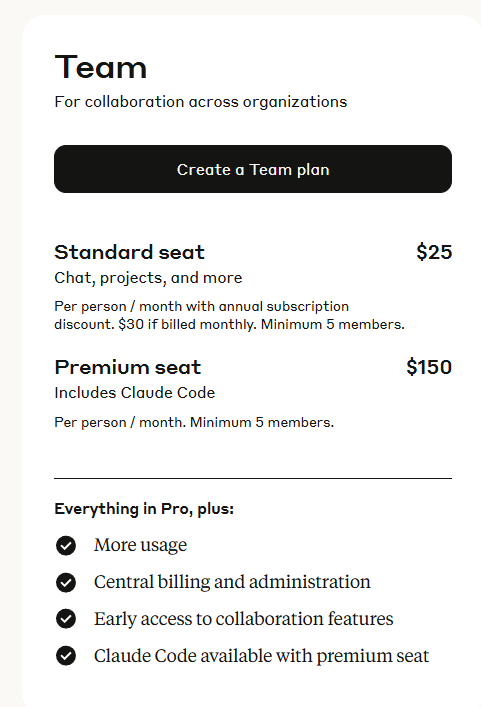
If you want to know more about Claude’s pricing plans and value for money, check out our in-depth guide.
Winner: All three platforms land in a similar price range for their entry tiers ($25-30 per user/month), but the way they structure value is very different.
Team-GPT comes out on top for pricing thanks to its tiered plans - from Free Forever up to Enterprise - that make it accessible to small marketing teams while still scaling to global organizations.
Claude Team keeps things simple with Standard and Premium seats, though the $150/month Premium option will be overkill for most marketing teams, with both Claude Team and ChatGPT Teams having a minimum number of required seats, immediately increasing the initial costs.
Team-GPT vs. ChatGPT Teams vs. Claude Team - What are the customers saying?
No matter how polished the feature lists look, the real test of any AI platform is how teams feel once they start using it.
Reviews give us a window into that day-to-day reality, shedding light on where the platforms shine, where they frustrate, and how they stack up in actual marketing workflows.
By looking at what users say about Team-GPT, ChatGPT Business, and Claude Team, we can cut through the hype and understand the real-world experience behind each tool.
Team-GPT reviews
G2 score: 4.8/5
What users love:
- Multi-model access in one place: Users consistently highlight how valuable it is to switch between and compare ChatGPT, Gemini, Claude, and others without juggling multiple subscriptions or tabs.
- Cross-comparison of answers: The ability to ask the same question across different models and see varied responses is described as “pure gold” for uncovering new perspectives.
- Collaboration and knowledge sharing: Teams appreciate having a central hub where they can co-write, store project knowledge, and stay consistent across campaigns.
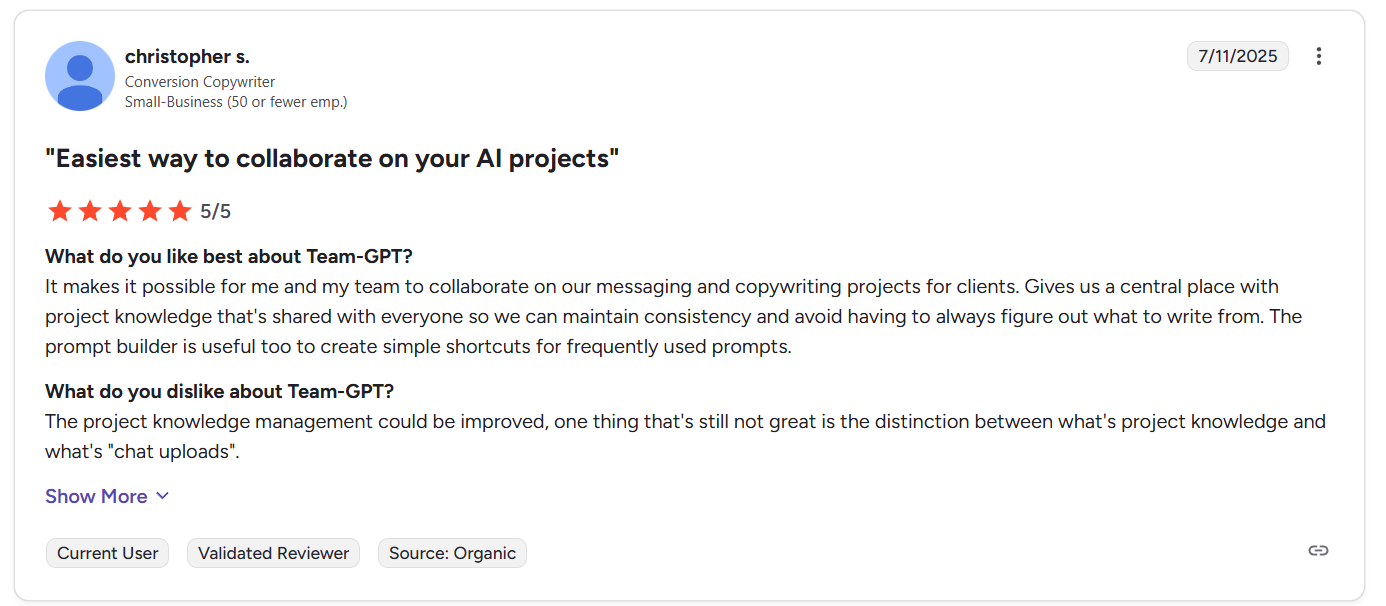
It makes it possible for me and my team to collaborate on our messaging and copywriting projects for clients. Gives us a central place with project knowledge that's shared with everyone so we can maintain consistency and avoid having to always figure out what to write from. The prompt builder is useful too to create simple shortcuts for frequently used prompts. - G2 Review
Common complaints include:
- Knowledge management clarity: Some users find the distinction between project knowledge and chat uploads confusing.
- Learning curve with rapid updates: Fast feature releases can cause UI changes that take time for teams to adjust to.
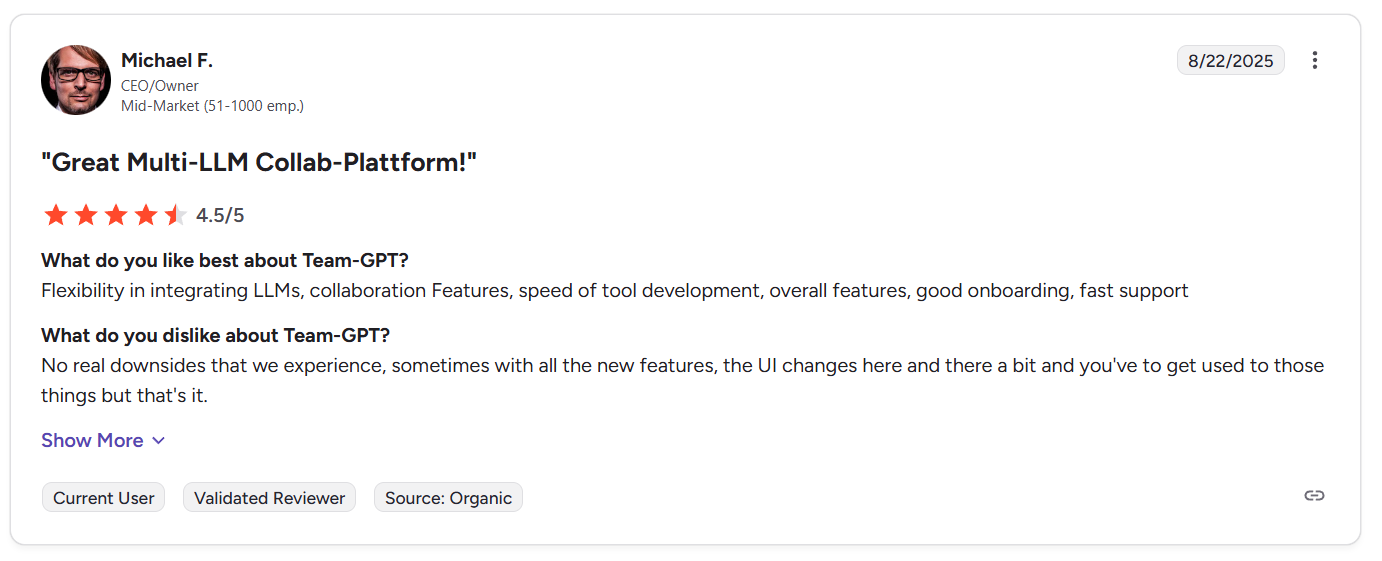
No real downsides that we experience, sometimes with all the new features, the UI changes here and there a bit and you've to get used to those things but that's it. - G2 Review
ChatGPT Teams reviews
G2 score: 4.7/5
Note: There are no reviews explicitly mentioning the Team (Business) plan. The reviews I found refer to ChatGPT in general.
What users love:
- Versatility across use cases: Reviewers highlight ChatGPT’s ability to handle everything from debugging code and generating boilerplate to drafting emails, creating blog posts, and breaking down complex topics into simple explanations.
- Advanced tools & integrations: Browsing, data analysis, and Canvas are called out as valuable for research, code execution, and collaborative editing.
- Multimodal capabilities: Support for text, image, PDFs, spreadsheets, and audio uploads makes ChatGPT a flexible assistant for both professional and academic tasks.
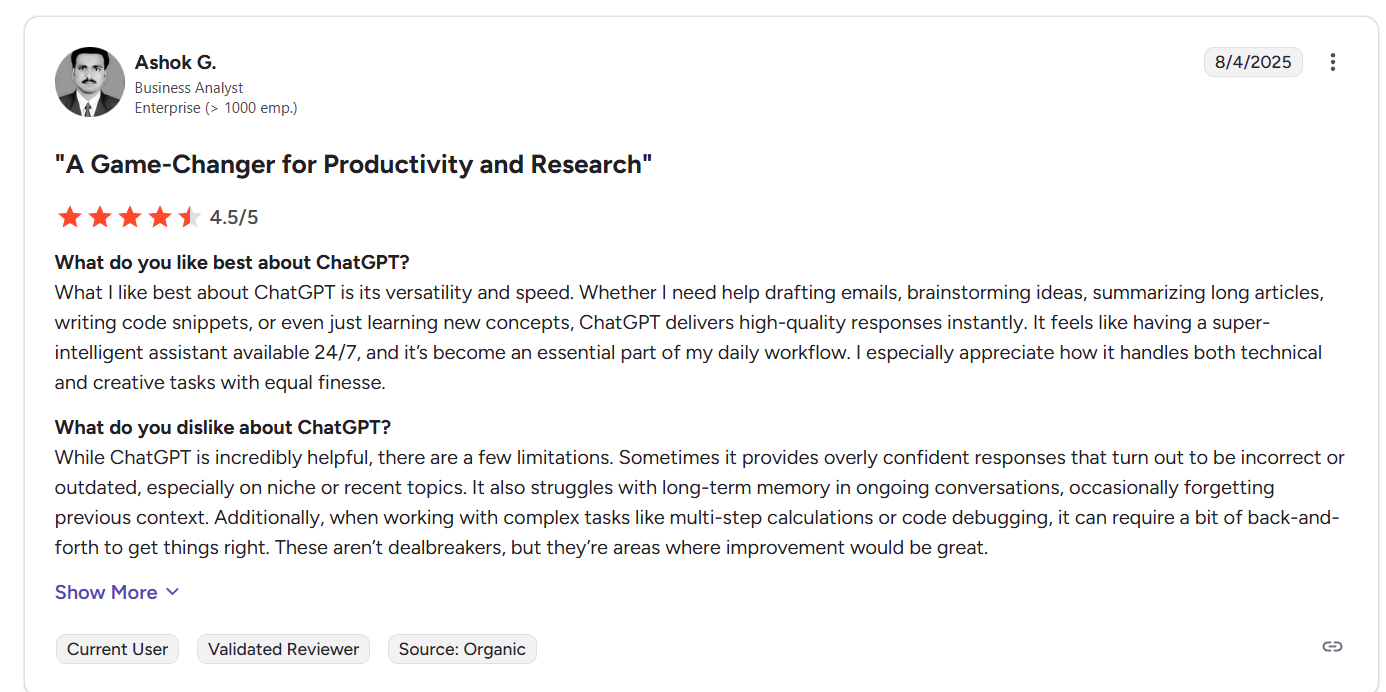
What I like best about ChatGPT is its versatility and speed. Whether I need help drafting emails, brainstorming ideas, summarizing long articles, writing code snippets, or even just learning new concepts, ChatGPT delivers high-quality responses instantly. - G2 Review
Common complaints include:
- Hallucinations and inaccuracies: Some reviewers note that GPT-5 occasionally fabricates details or even overwrites working code during debugging. Confident but wrong answers remain a concern, especially on technical or niche topics.
- Outdated or missing information: Because it isn’t always connected to real-time data (outside browsing), responses can sometimes lag behind current events.
- Visual generation: A few reviewers say its image outputs lag behind competitors like Gemini in quality.
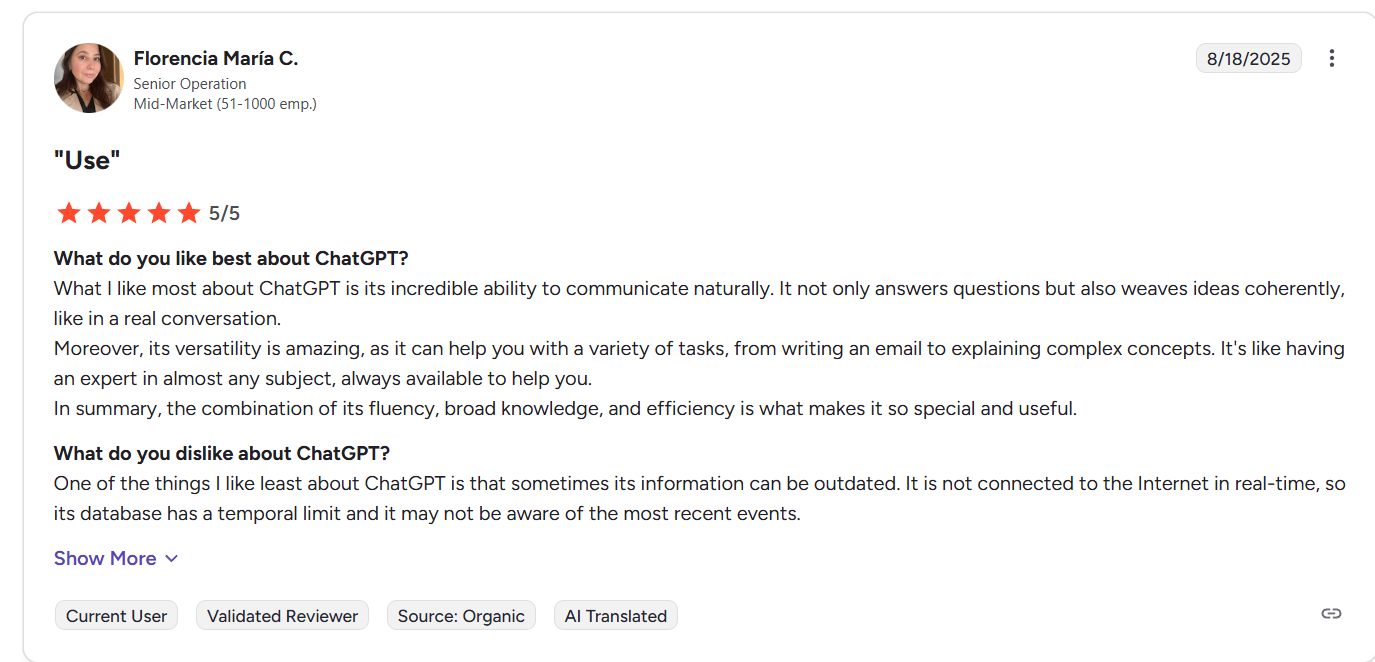
One of the things I like least about ChatGPT is that sometimes its information can be outdated. It is not connected to the Internet in real-time, so its database has a temporal limit and it may not be aware of the most recent events. - G2 Review
Claude Team reviews
G2 rating: 4.4/5
Note: The same applies to Claude - the reviews I found mostly talk about Claude in general, not individual plans.
What users love:
- Visualization & research: Claude is praised for top-tier data visualization and helping teams organize, structure, and simplify research projects.
- Transparency & honesty: Users appreciate that Claude is more likely to admit gaps or uncertainty rather than “hallucinate” confidently wrong answers.
- Strong performance on data-heavy tasks: Marketers and analysts praise its ability to generate tables, charts, and structured insights, making complex data easier to digest.
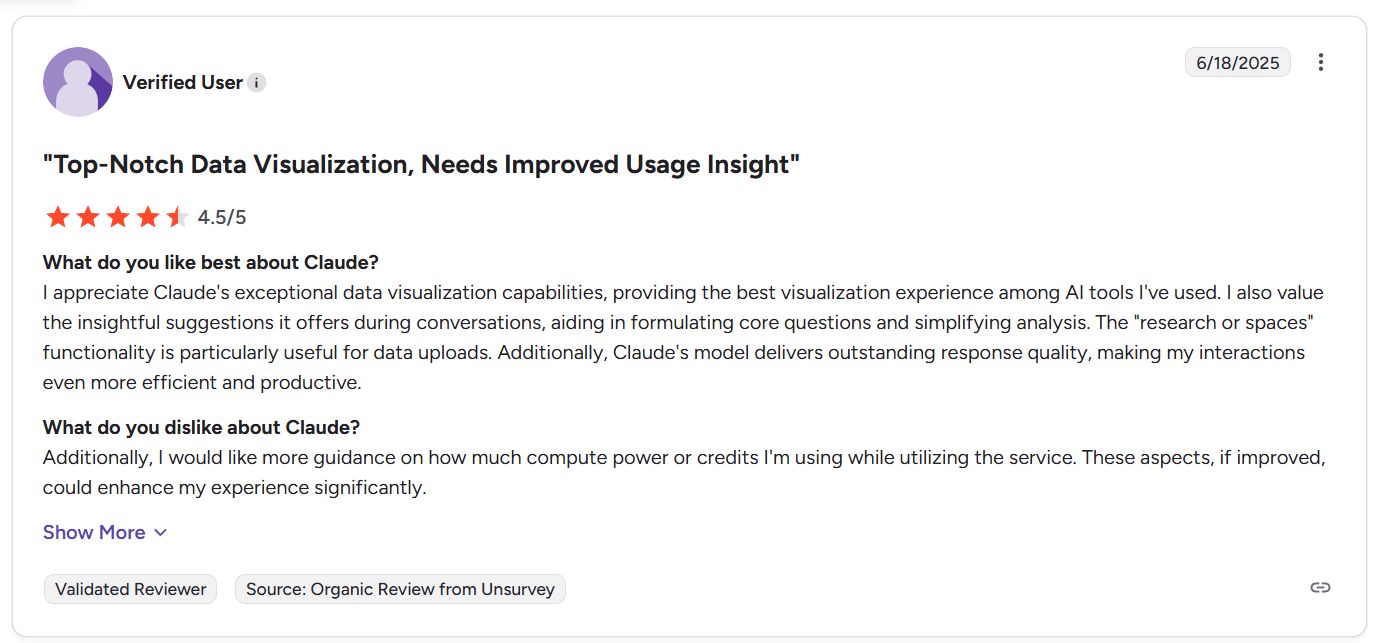
I appreciate Claude's exceptional data visualization capabilities, providing the best visualization experience among AI tools I've used. I also value the insightful suggestions it offers during conversations, aiding in formulating core questions and simplifying analysis. The "research or spaces" functionality is particularly useful for data uploads. - G2 Review
Common complaints include:
- Quality inconsistencies: Some users find its text outputs too rough, emotional, or promotional compared to ChatGPT’s polish.
- Usage limits: Message caps and enforced “timeouts” frustrate users who hit limits during longer sessions.
- Issues with following directions: A number of reviewers report Claude completing only part of a task, requiring extra prompts that eat into message limits.
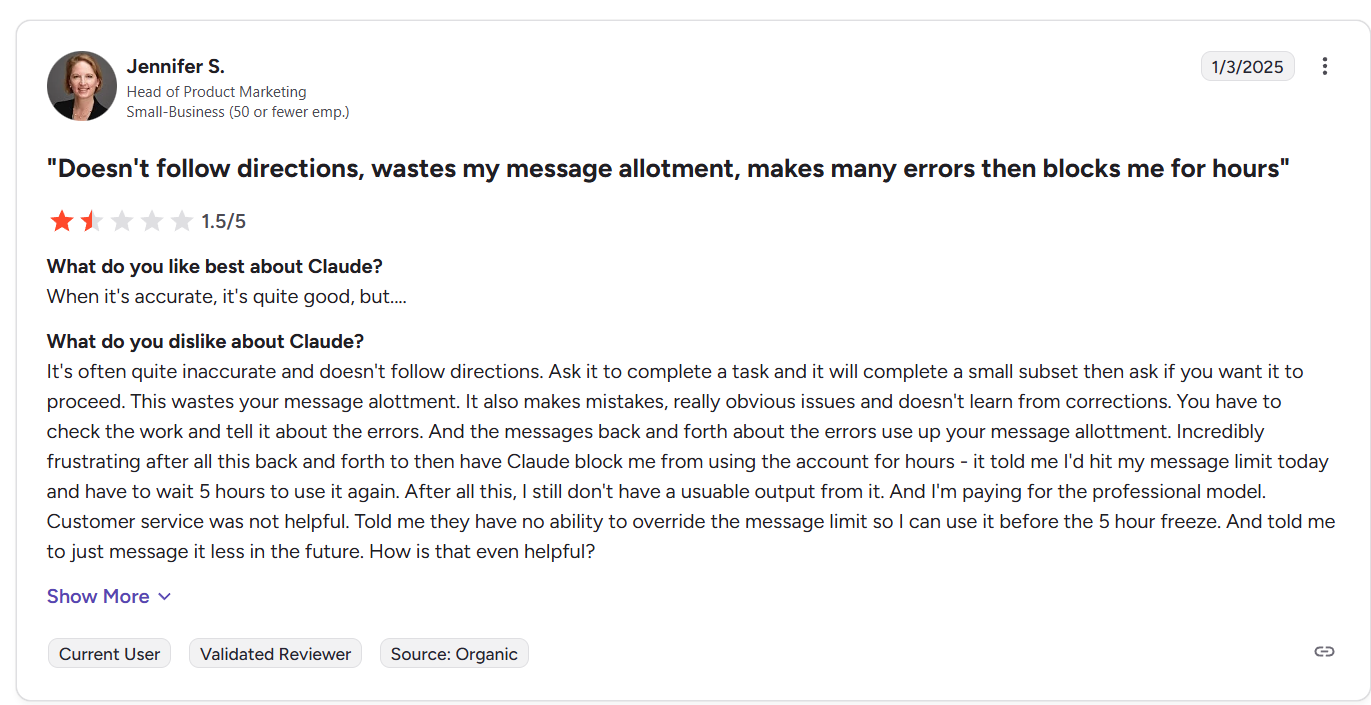
It's often quite inaccurate and doesn't follow directions. Ask it to complete a task and it will complete a small subset then ask if you want it to proceed. This wastes your message allotment. It also makes mistakes, really obvious issues and doesn't learn from corrections. - G2 Review
Final verdict: Team-GPT, ChatGPT Teams, or Claude Team?
Each of these platforms brings something unique to the table:
- Team-GPT stands out as the best choice for marketing teams that need structure, collaboration, and brand consistency at scale. Its model-agnostic flexibility, built-in prompt libraries, knowledge hubs, analytics, and real-time co-editing features make it a true collaboration platform designed to keep campaigns aligned, consistent, and measurable.
- ChatGPT Teams is the easiest entry point for teams that want plug-and-play AI with enterprise security and direct access to OpenAI’s latest models.
- Claude Team shines when deep reasoning, large context windows, or creative long-form content are priorities, making it a strong partner for research-heavy or strategy-driven work.
In short, if you’re looking for a general AI assistant, ChatGPT Business or Claude Team will serve you well.
But if your goal is to run marketing operations with AI as a team, Team-GPT is the clear winner in 2025.
Next steps for enterprises looking to adopt AI
For enterprises, adopting AI isn’t about one-off experiments - it’s about building a secure, scalable system that saves time, reduces costs, and drives consistent results across departments.
That’s where Team-GPT excels.
With its multi-model flexibility, centralized project knowledge, and enterprise-grade security, it’s designed for companies rolling AI out at scale.
Take saas.group, a global SaaS operator managing over 150 employees across multiple acquired businesses that needed a way to securely integrate multiple LLMs, unify workflows, and avoid over-reliance on a single vendor.
By adopting Team-GPT, they:
- Saved over 50,000 hours annually across programming, content creation, and ideation tasks.
- Sent more than 120,000 AI chat messages in 9,500+ conversations, all organized into shared knowledge hubs.
- Boosted collaboration across 180 users with prompt templates for sales, marketing, and technical teams.
- Maintained data security and compliance through enterprise-grade privacy standards and access controls.
- Benefited from a flexible billing model, paying only for what they used.
If your enterprise is also ready to move past fragmented AI adoption and into a unified system that boosts productivity without compromising on security, Team-GPT is the platform to do it.
Book a live demo today and our experts will show you how to roll out Team-GPT in a way that fits your team’s workflows, security standards, and growth targets.
Read more
- Top 10 Claude Team Alternatives For Marketing In 2025
- Team-GPT vs. Perplexity Enterprise Pro For Marketing
- ChatGPT Teams Alternatives for Marketing [2025]
- Top 10 Perplexity Enterprise Pro Alternatives For Marketing In 2025
- Team-GPT vs. Claude Teams For Marketing [2025]
- Team-GPT vs. ChatGPT Teams For Marketing [2025]


